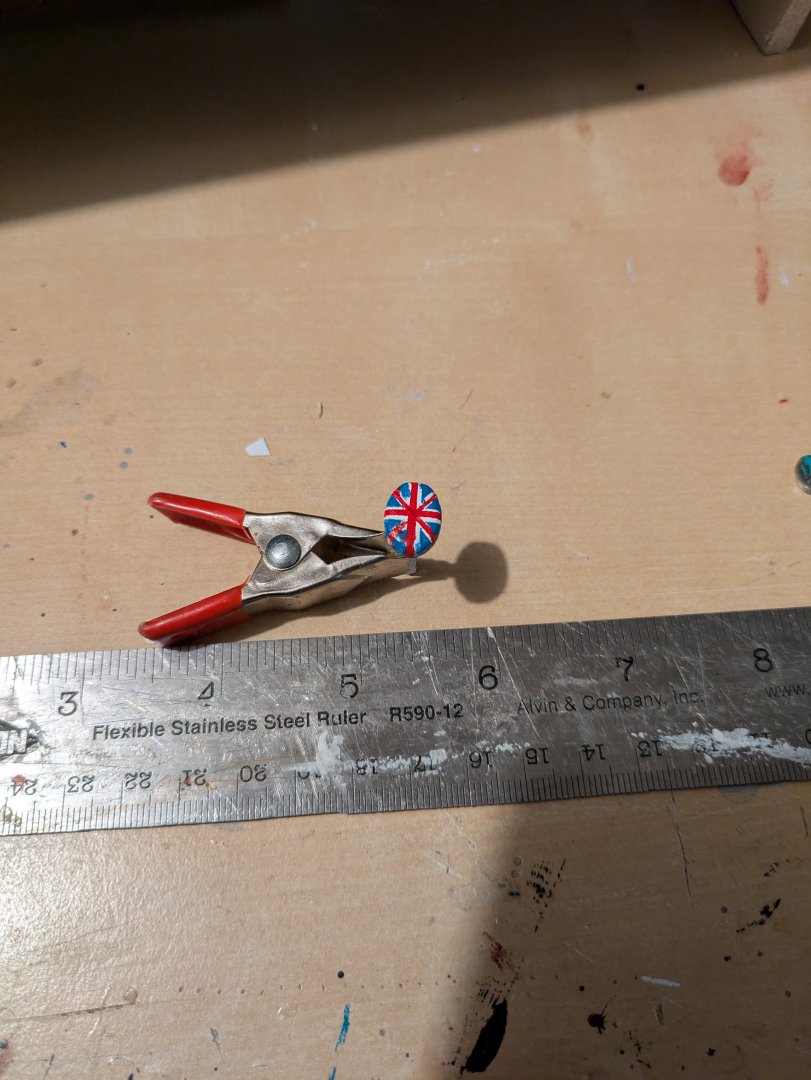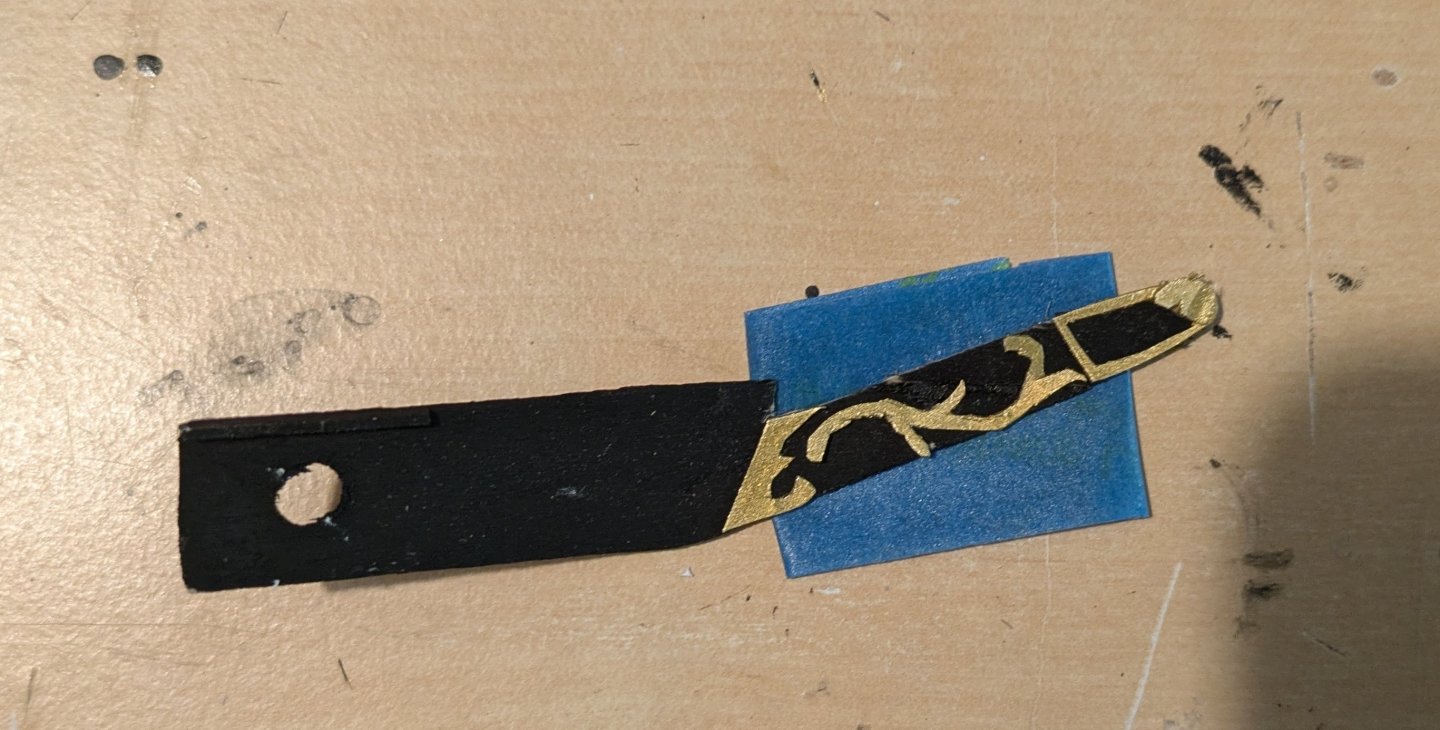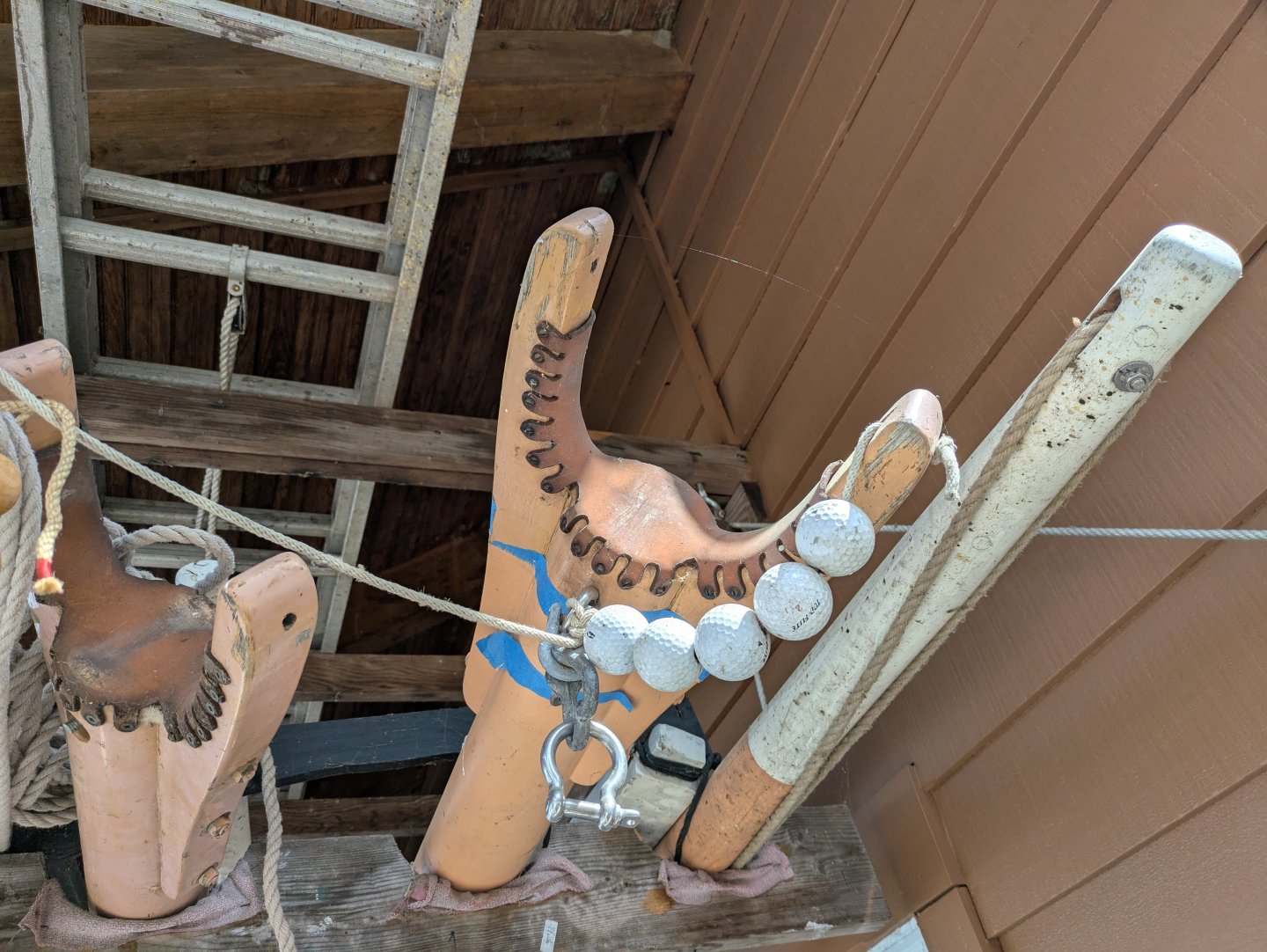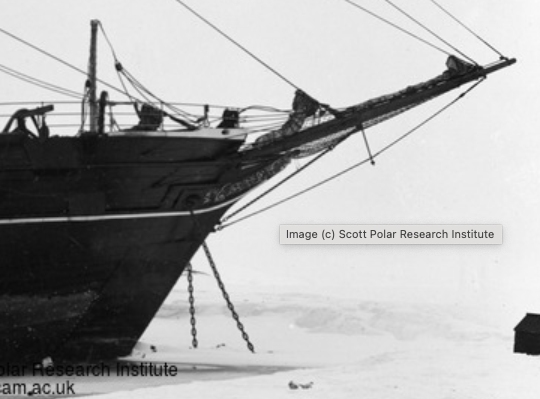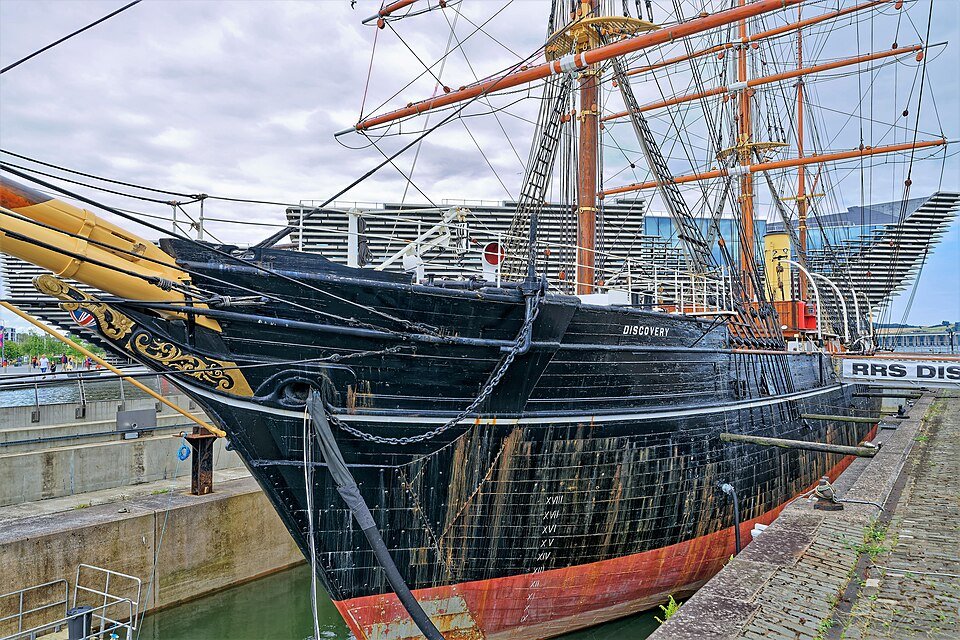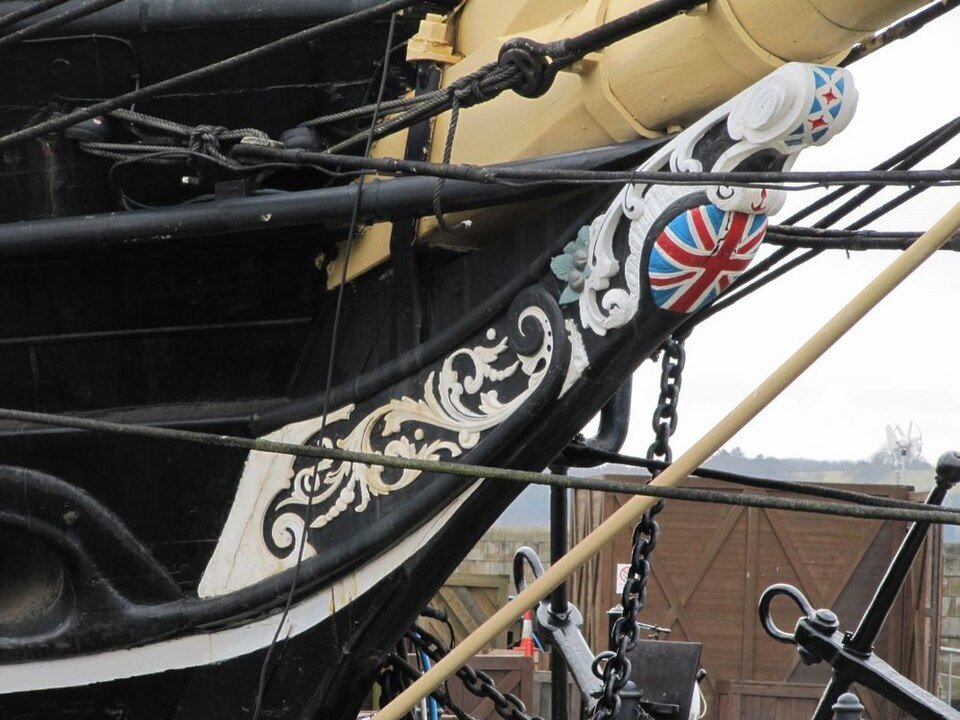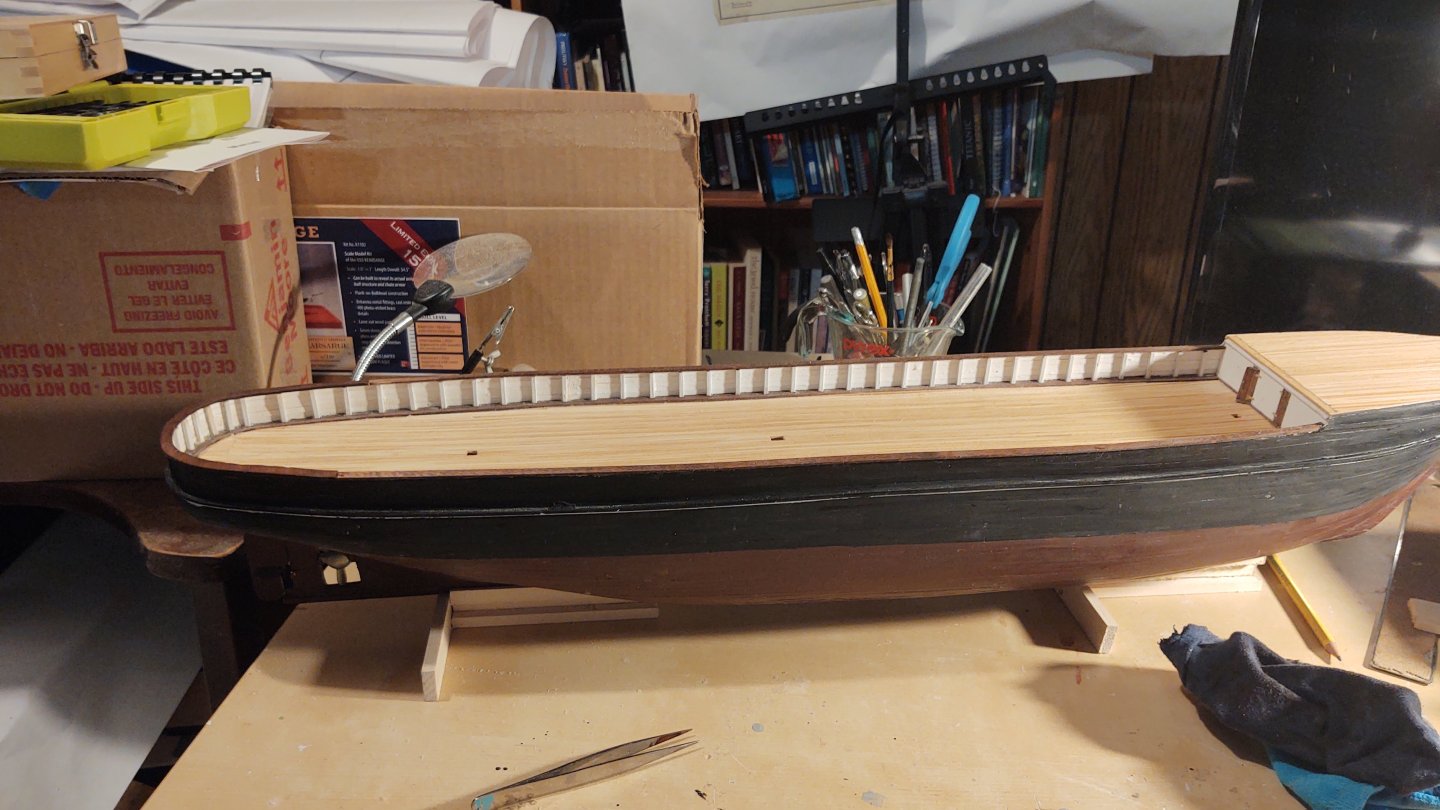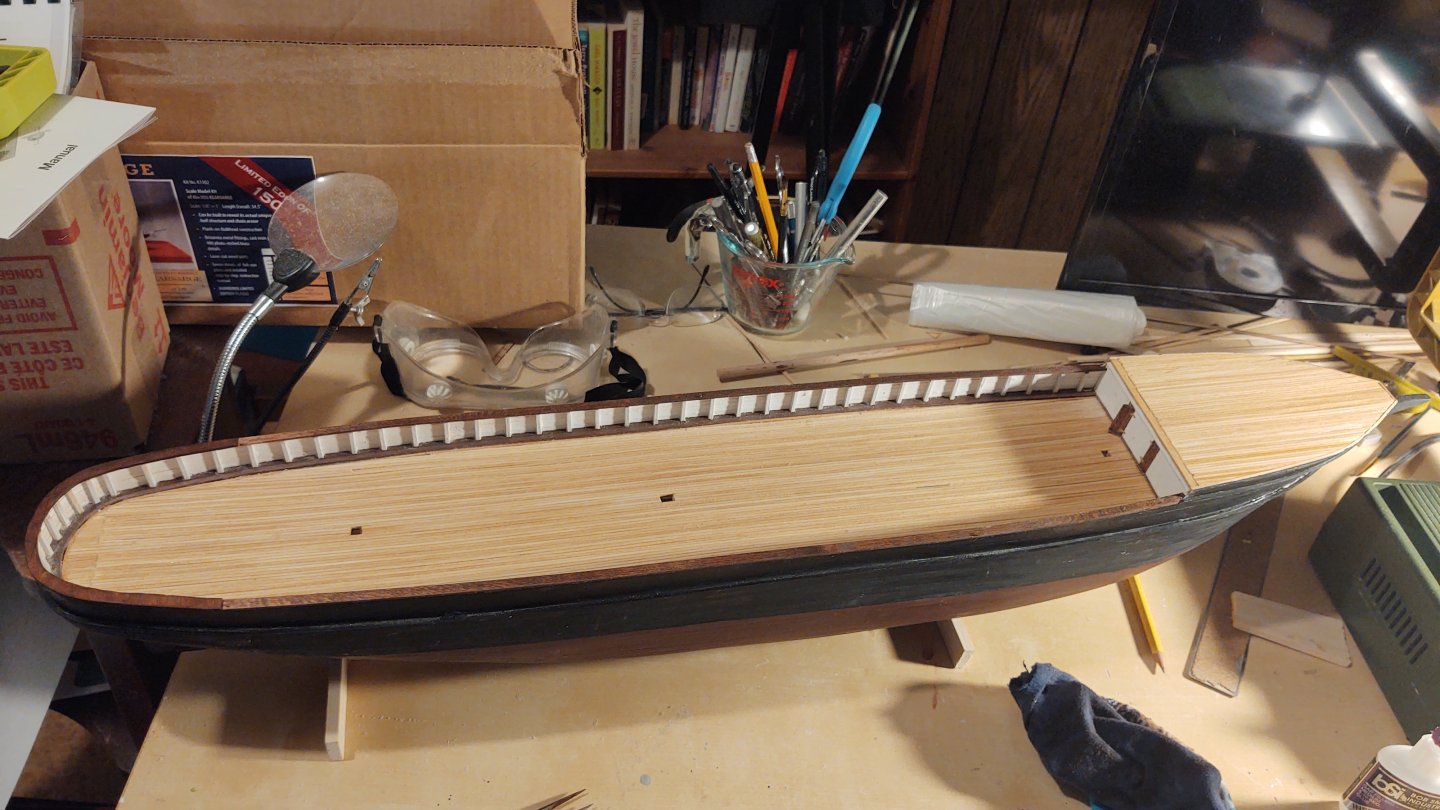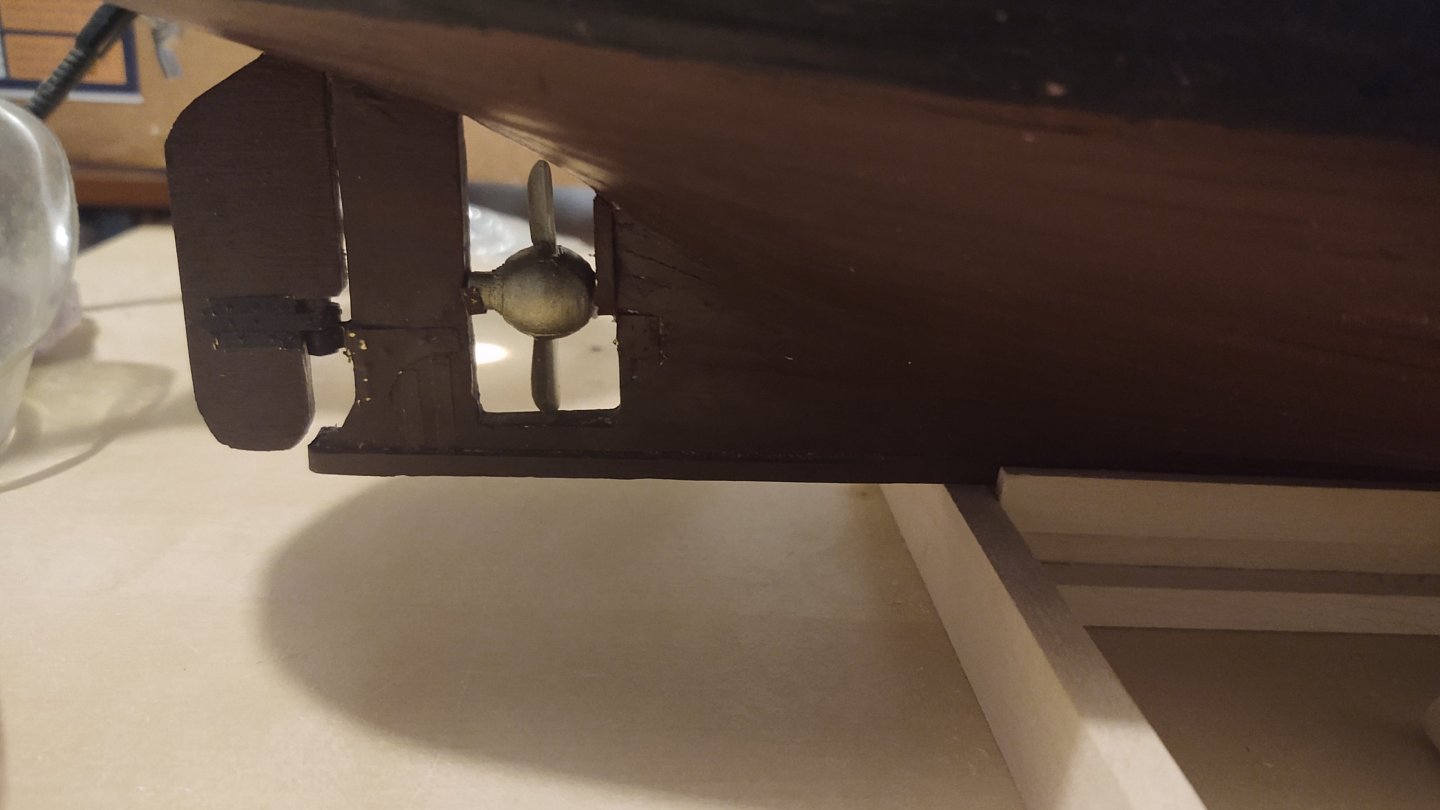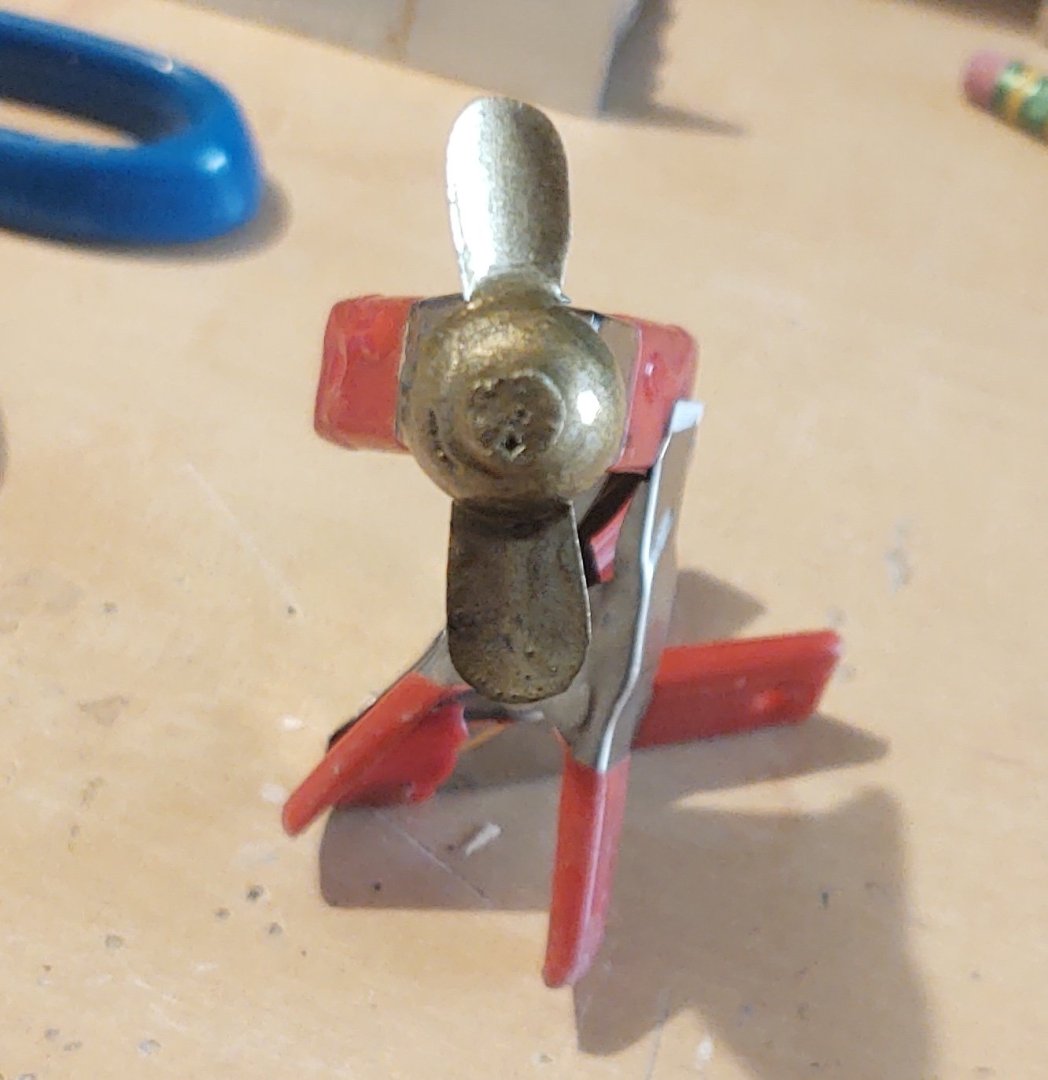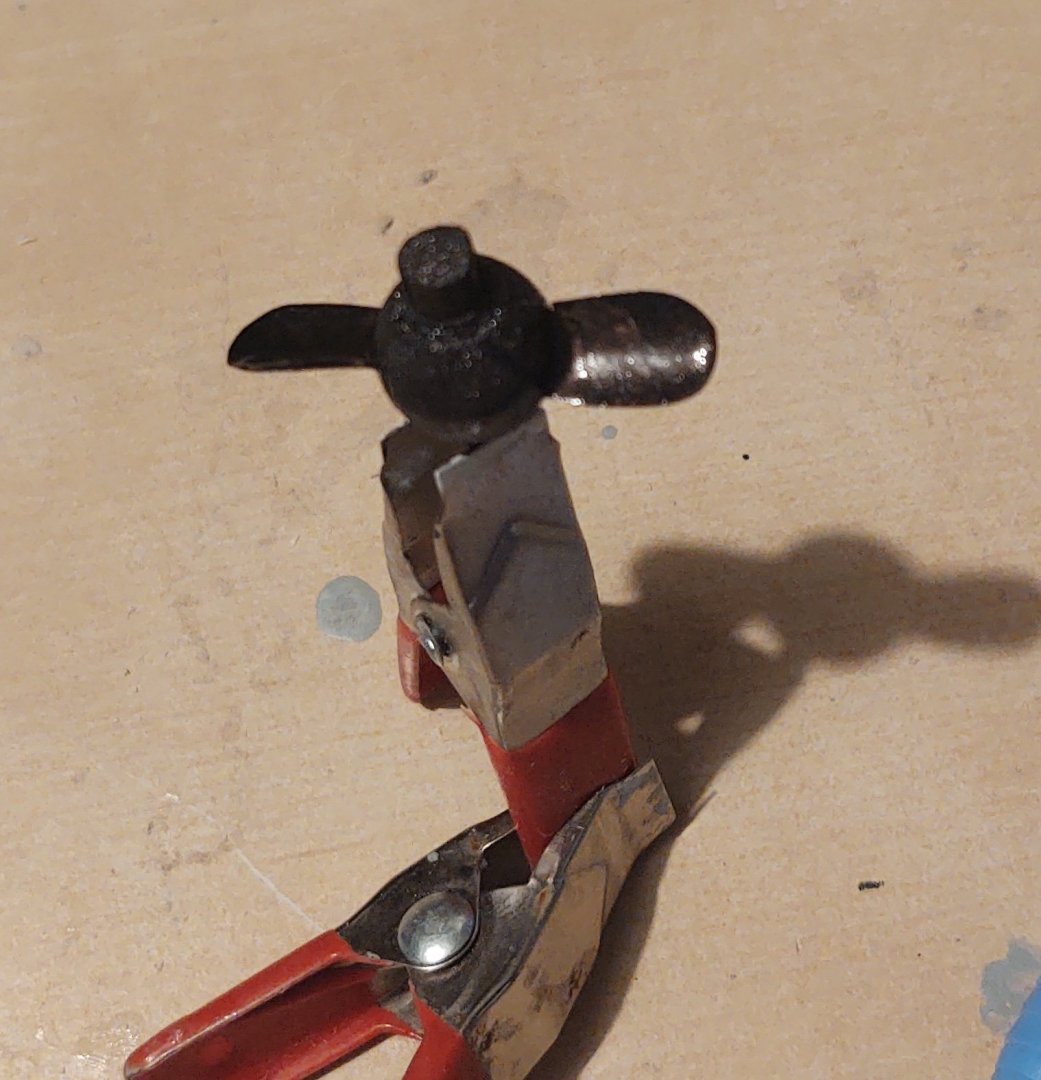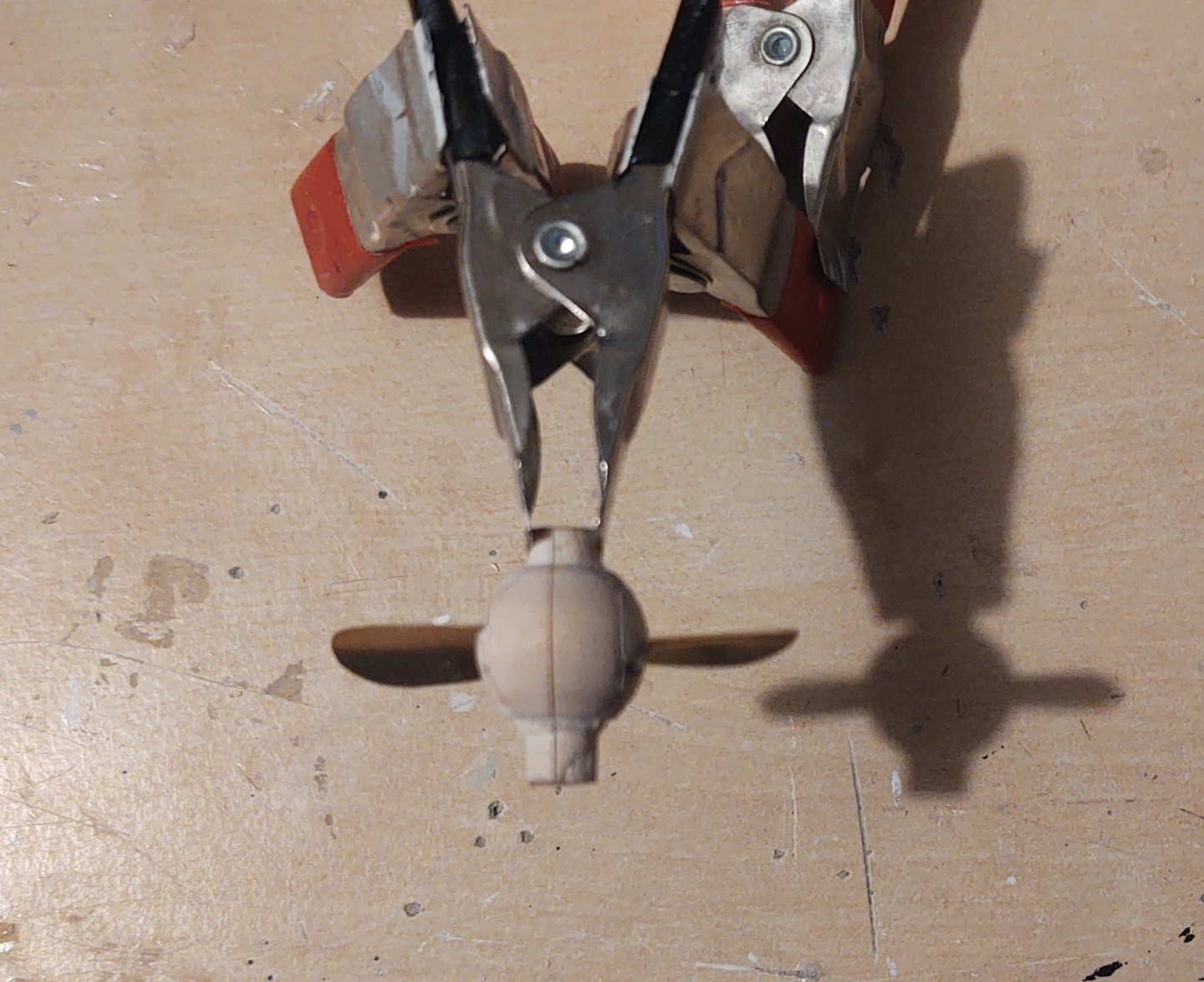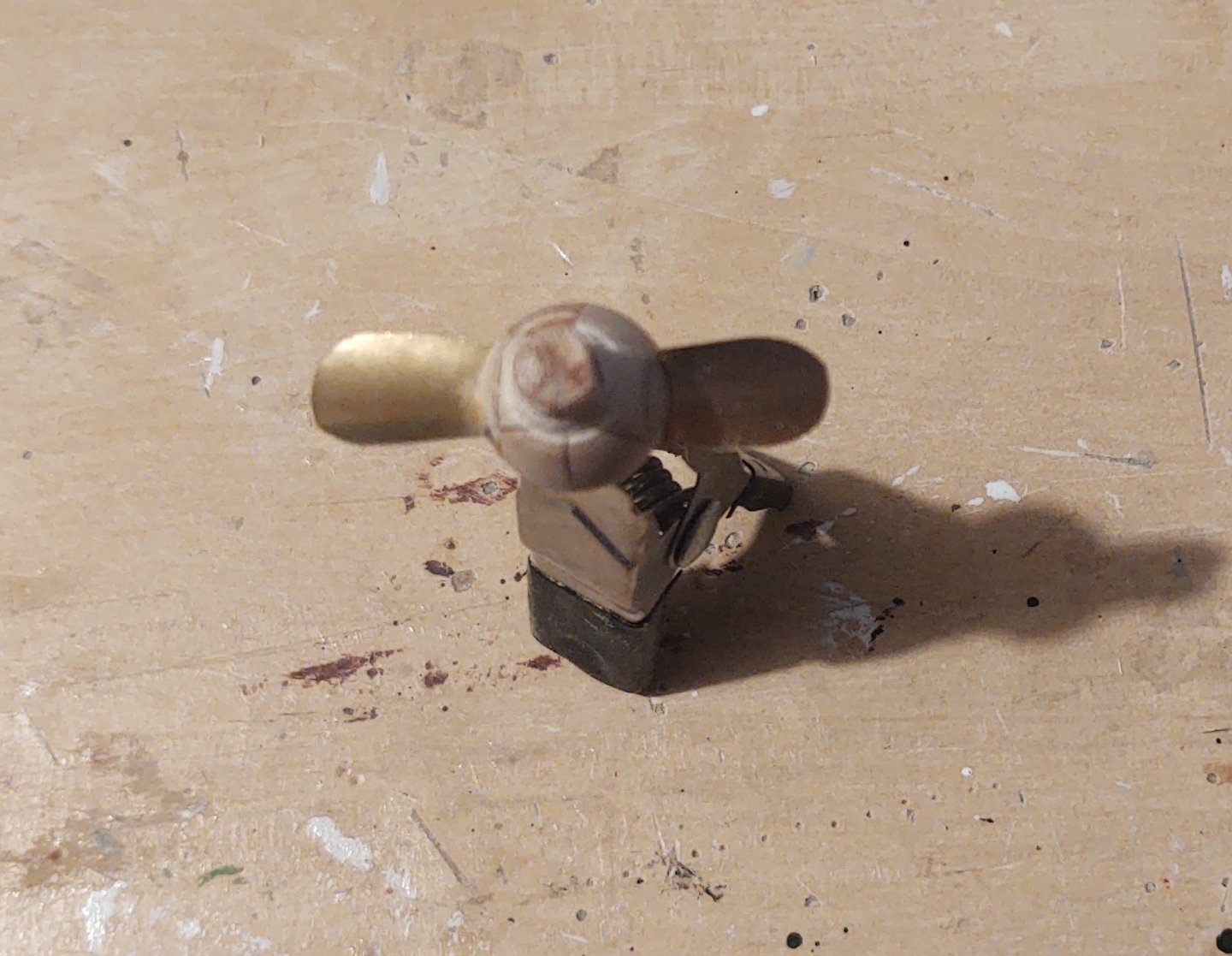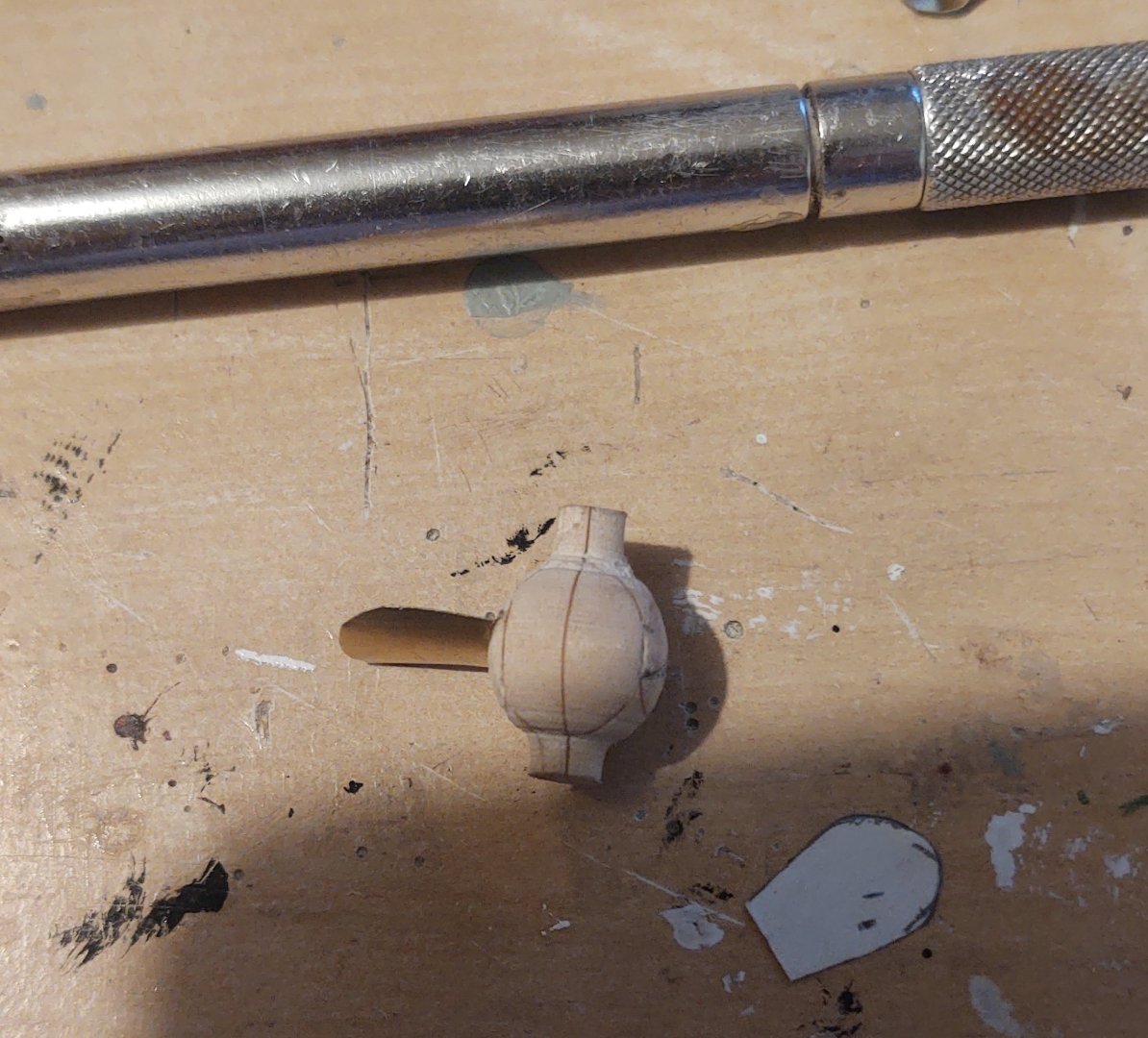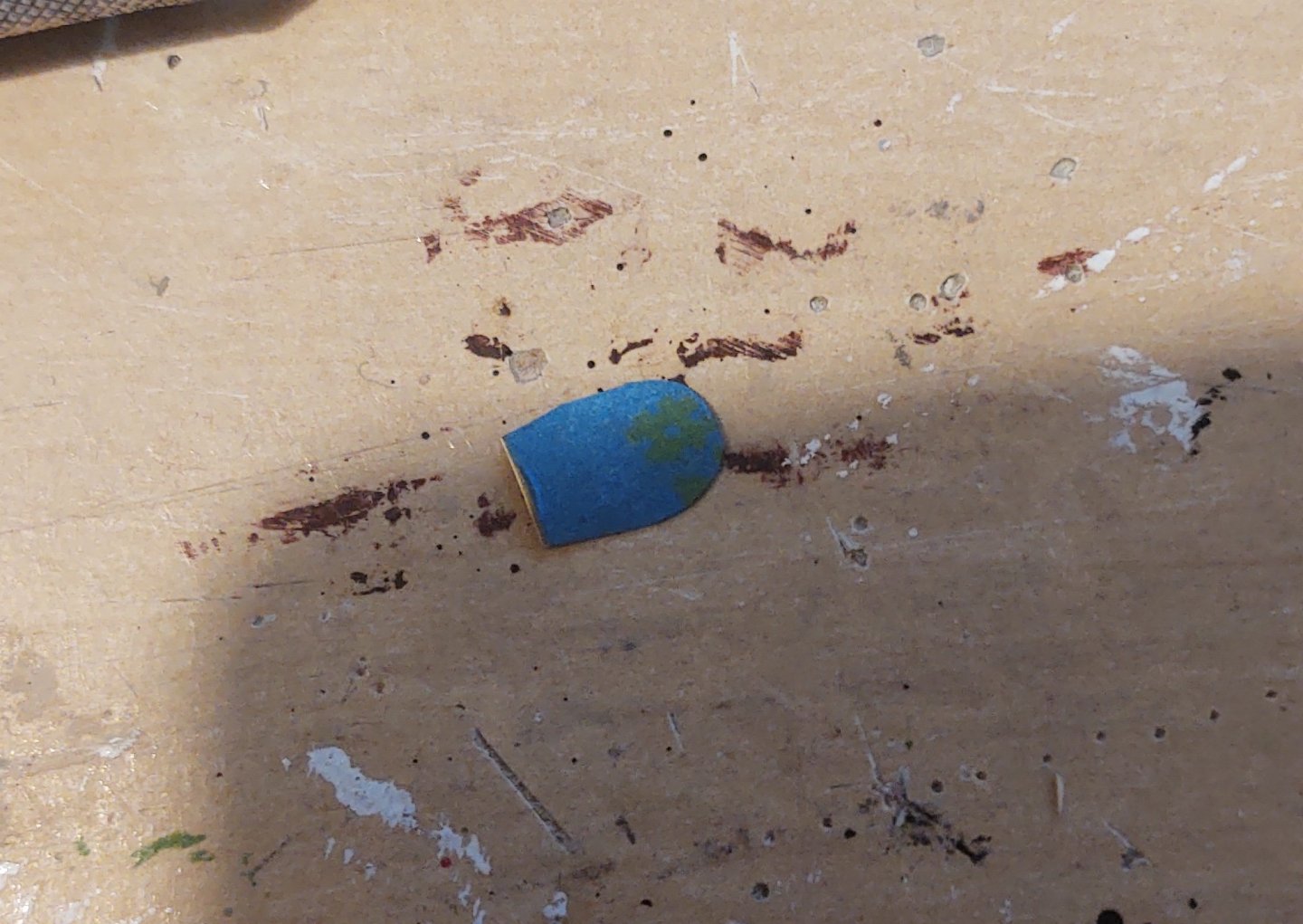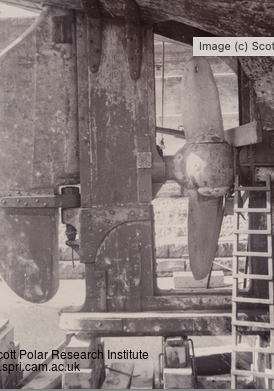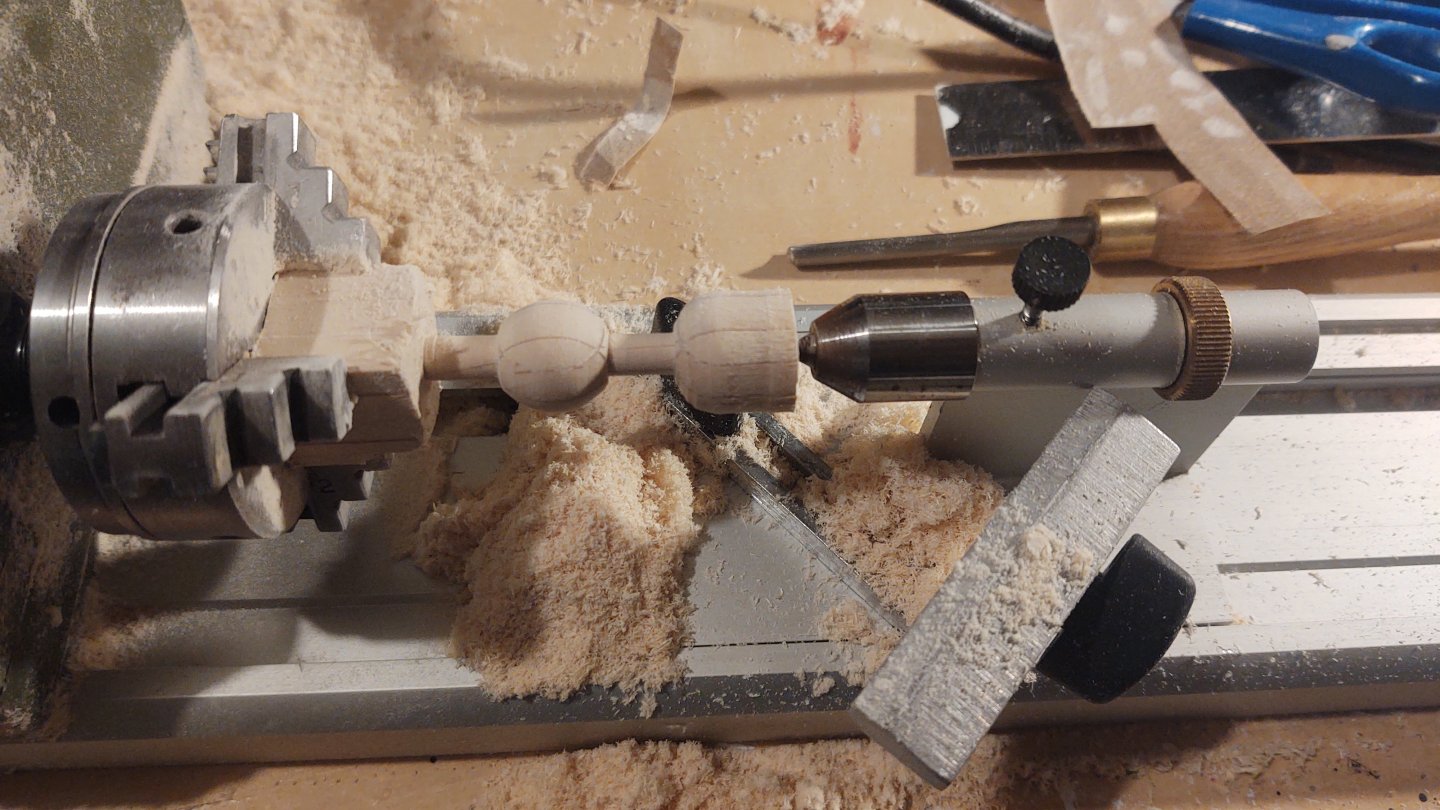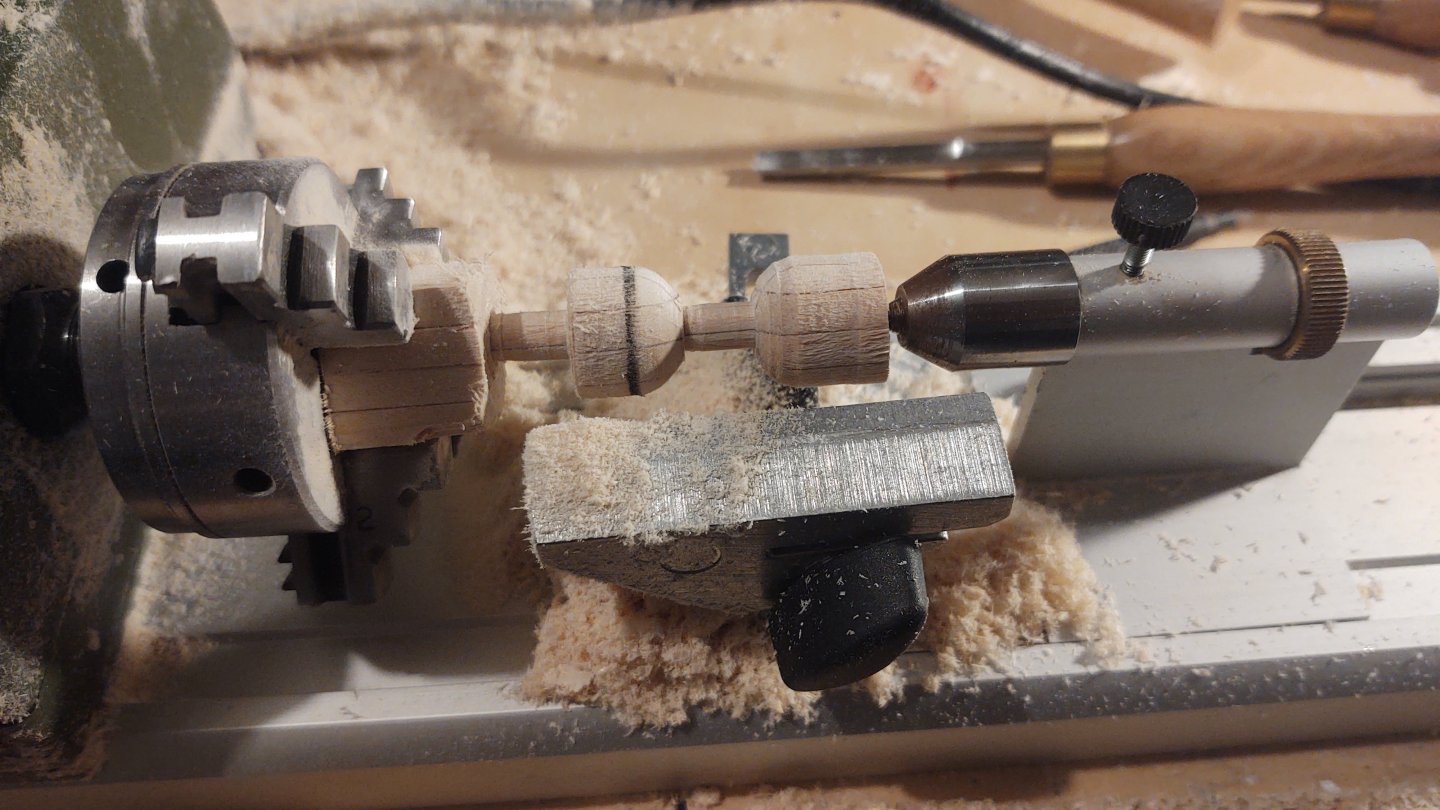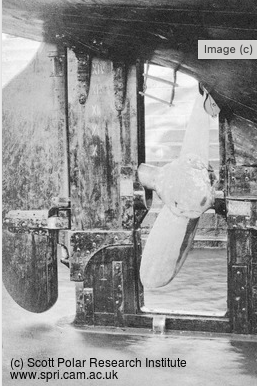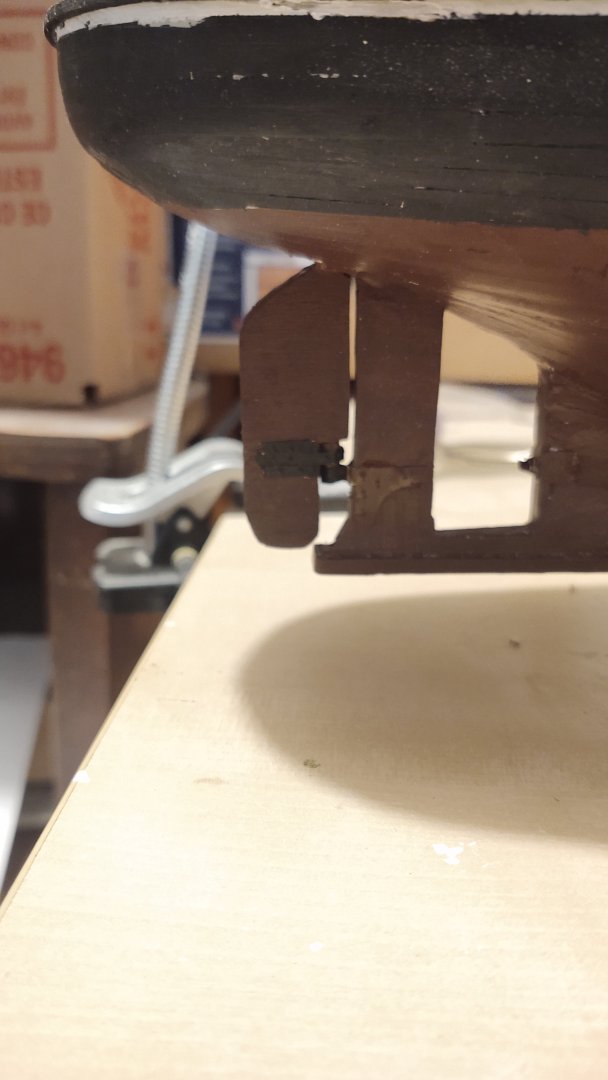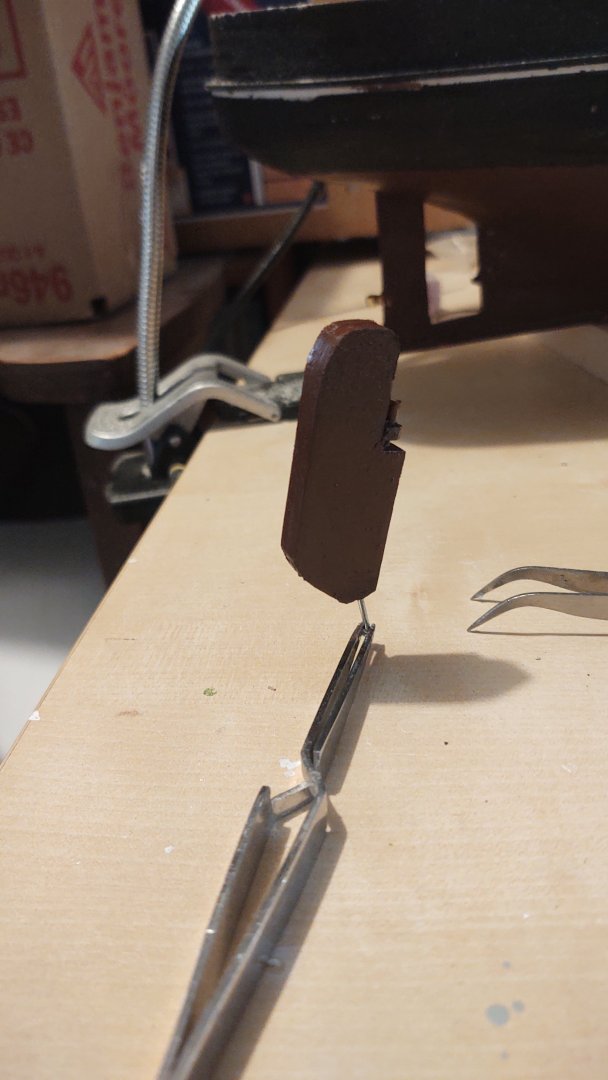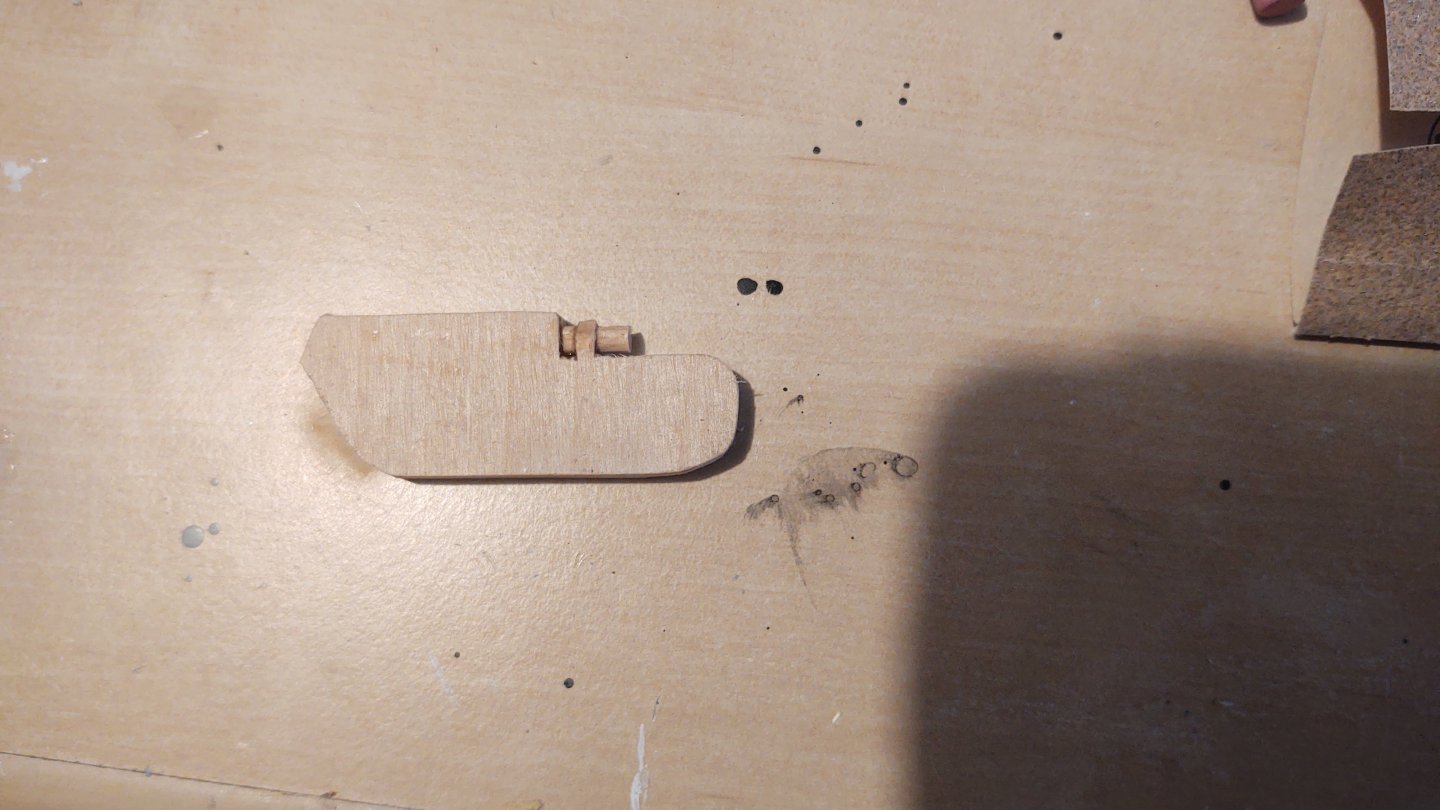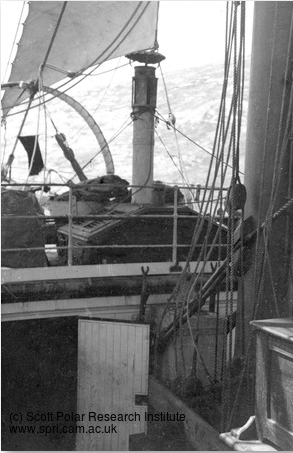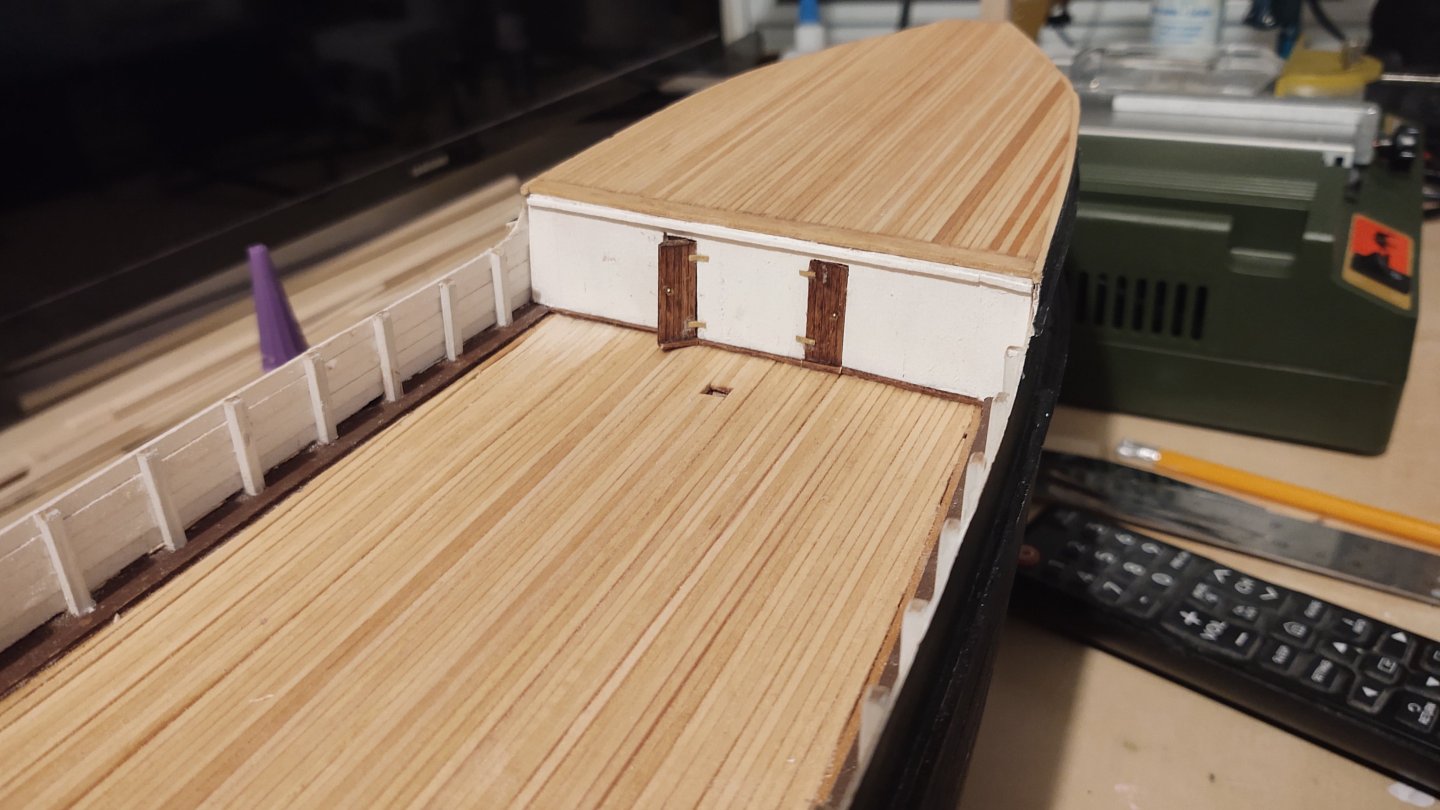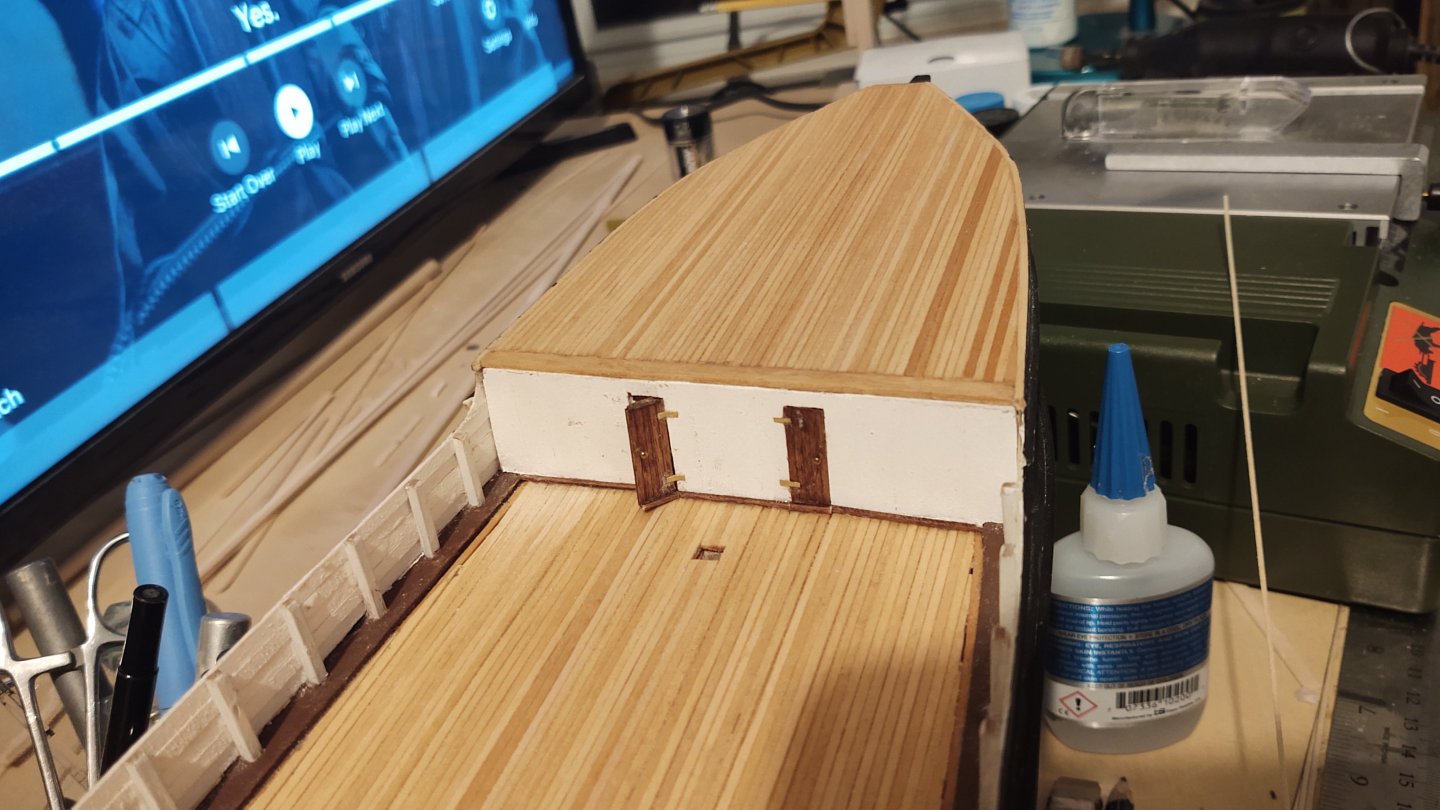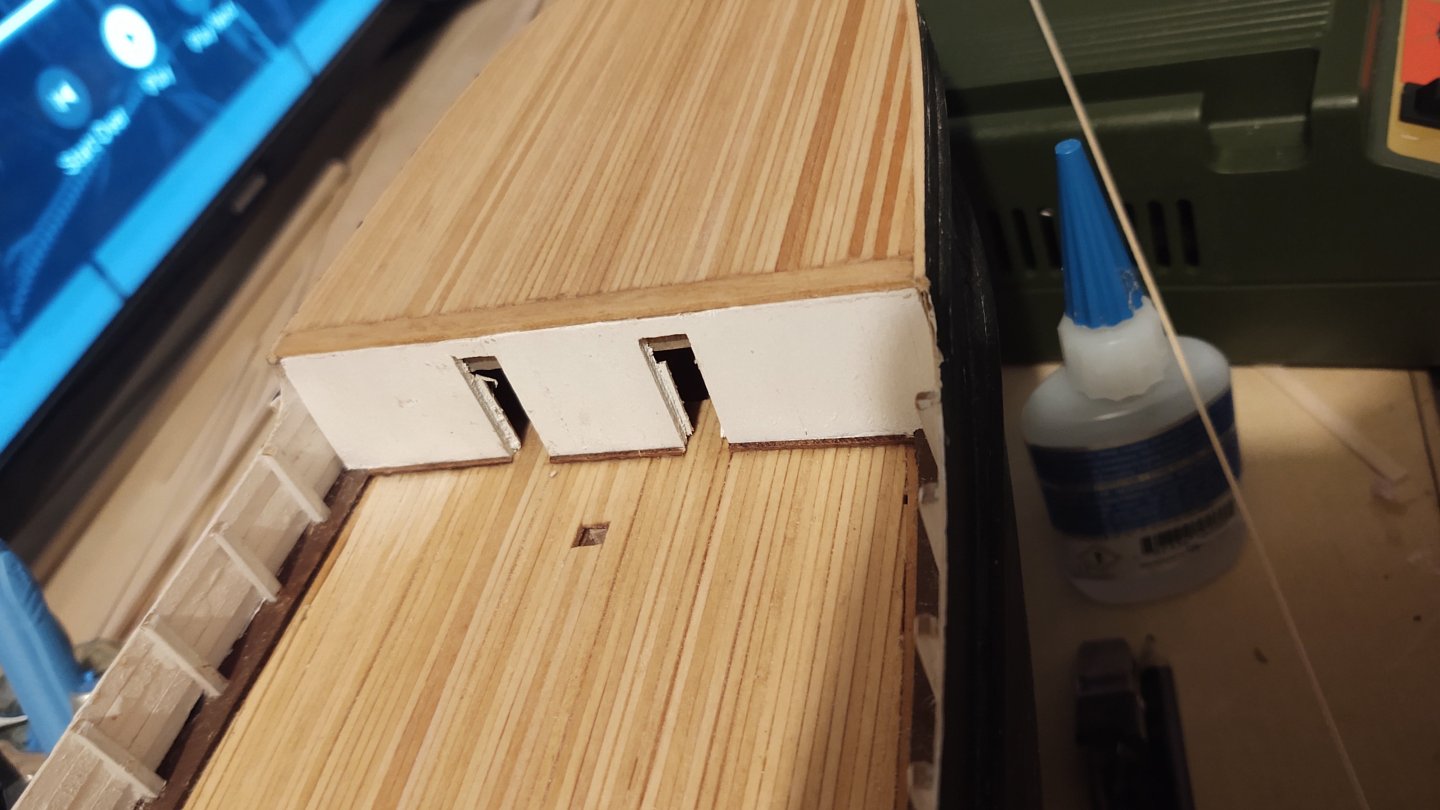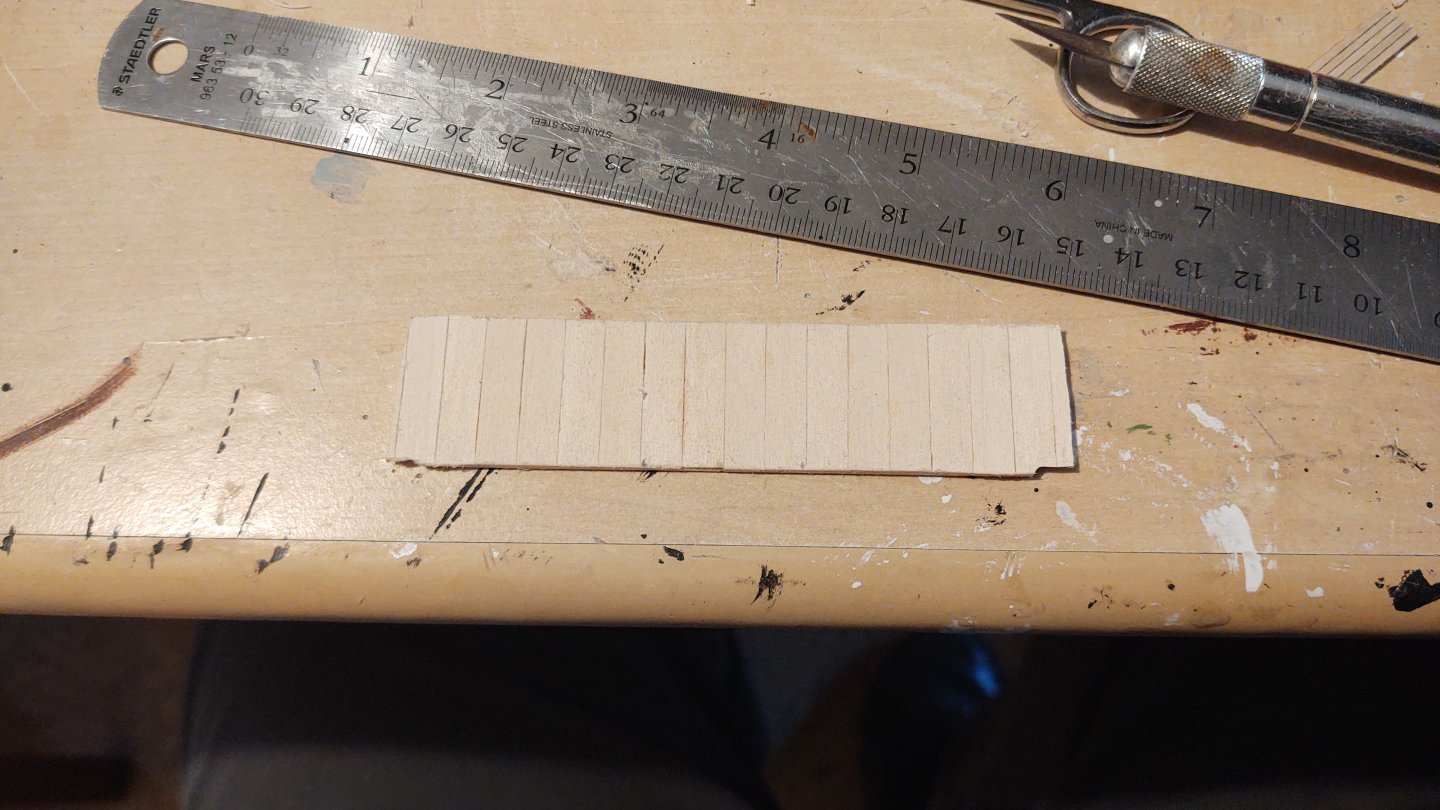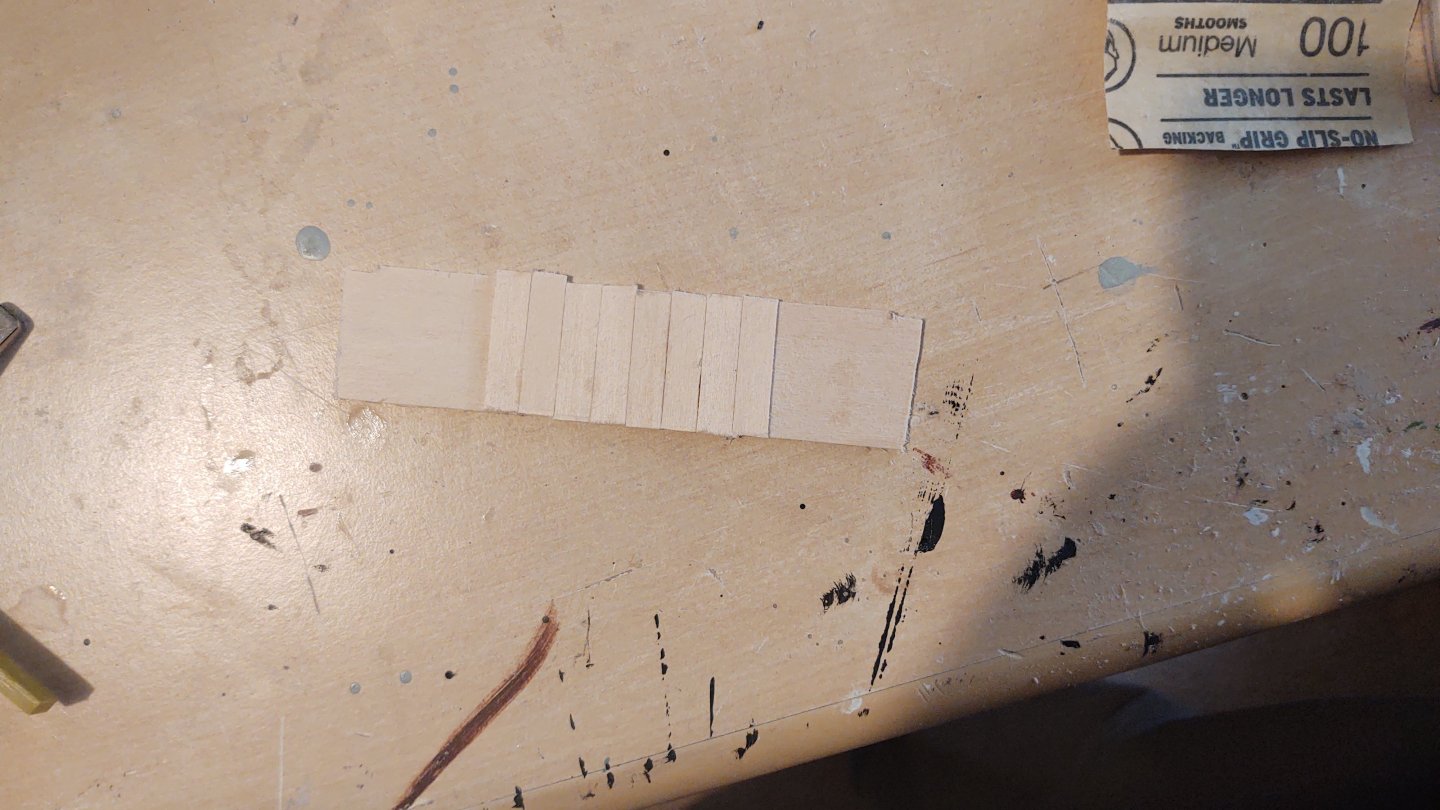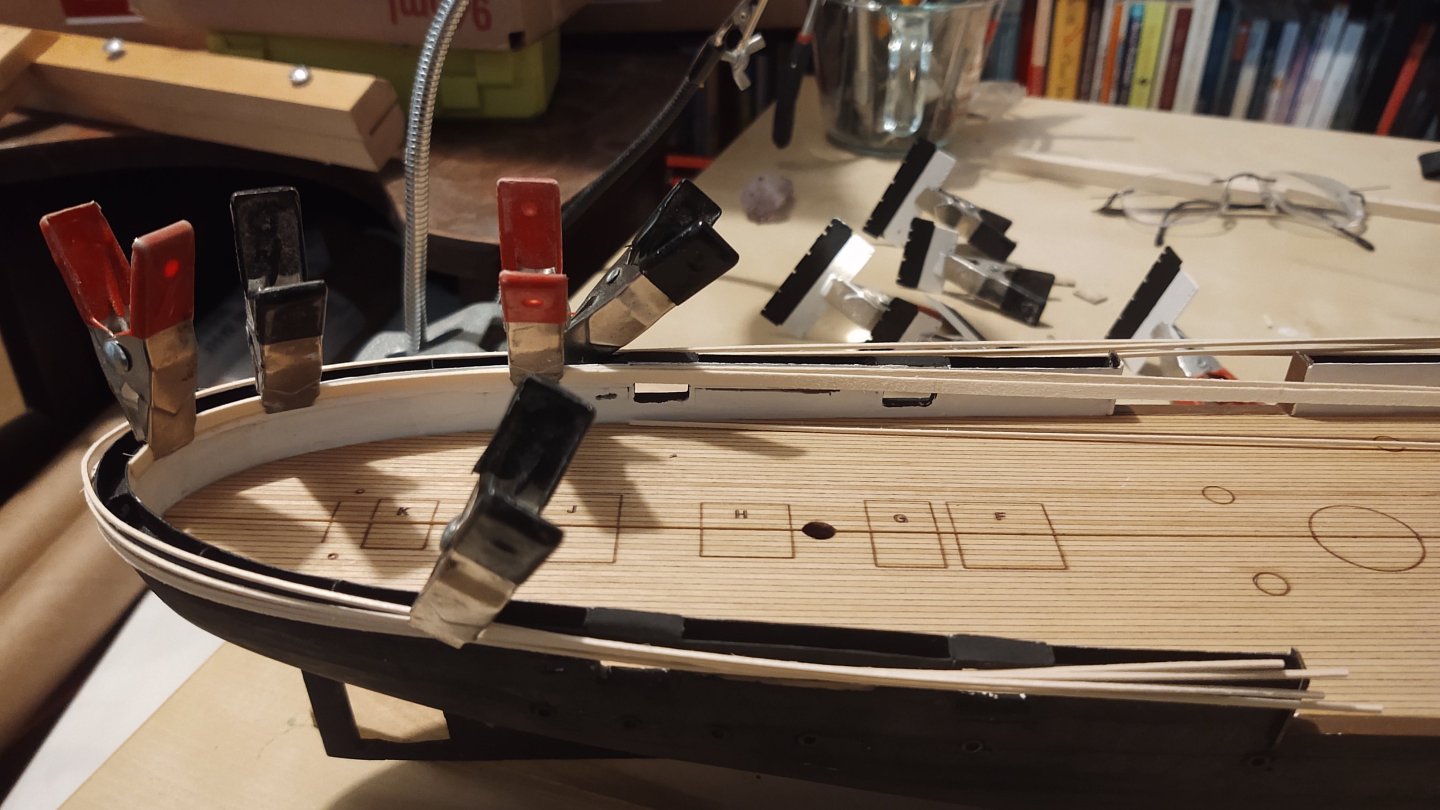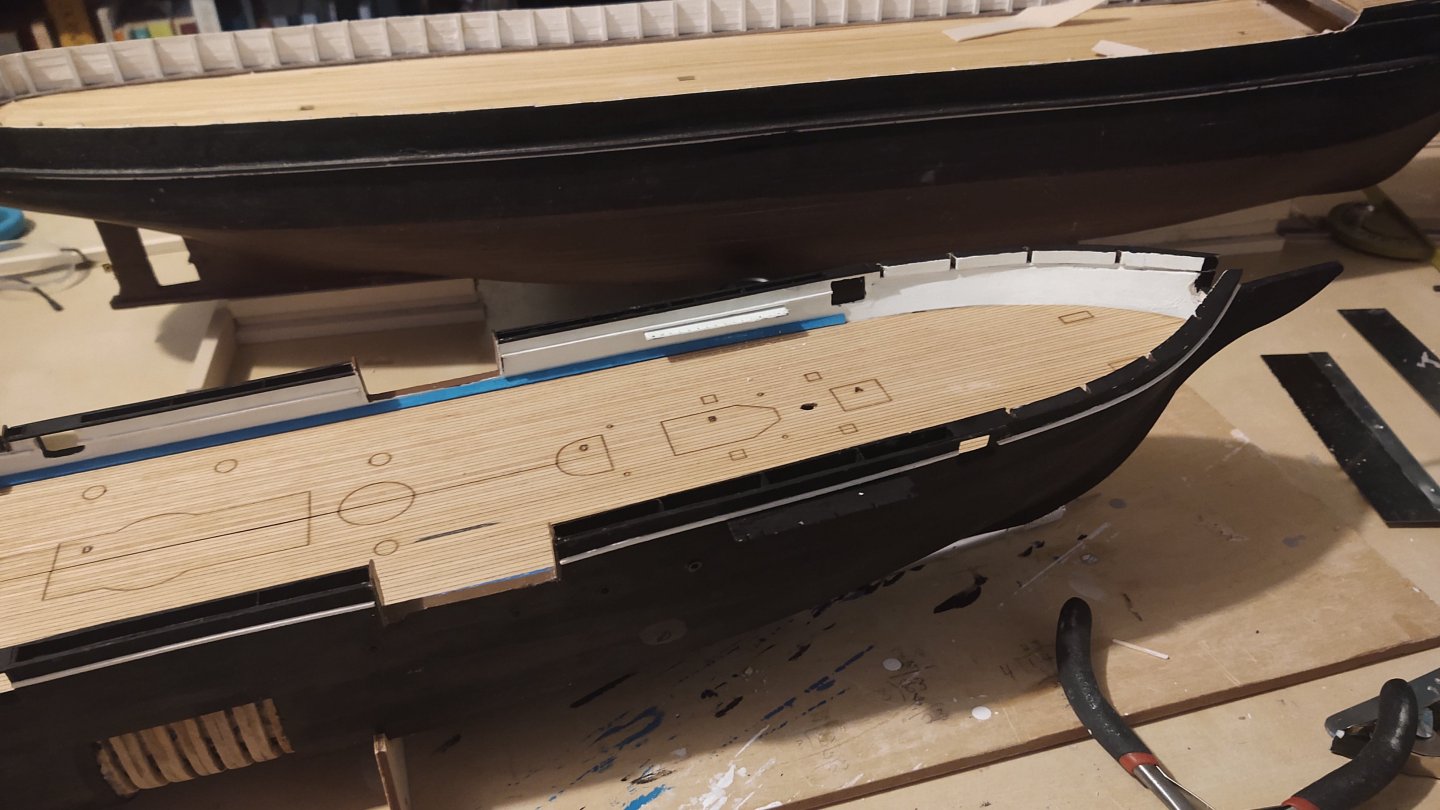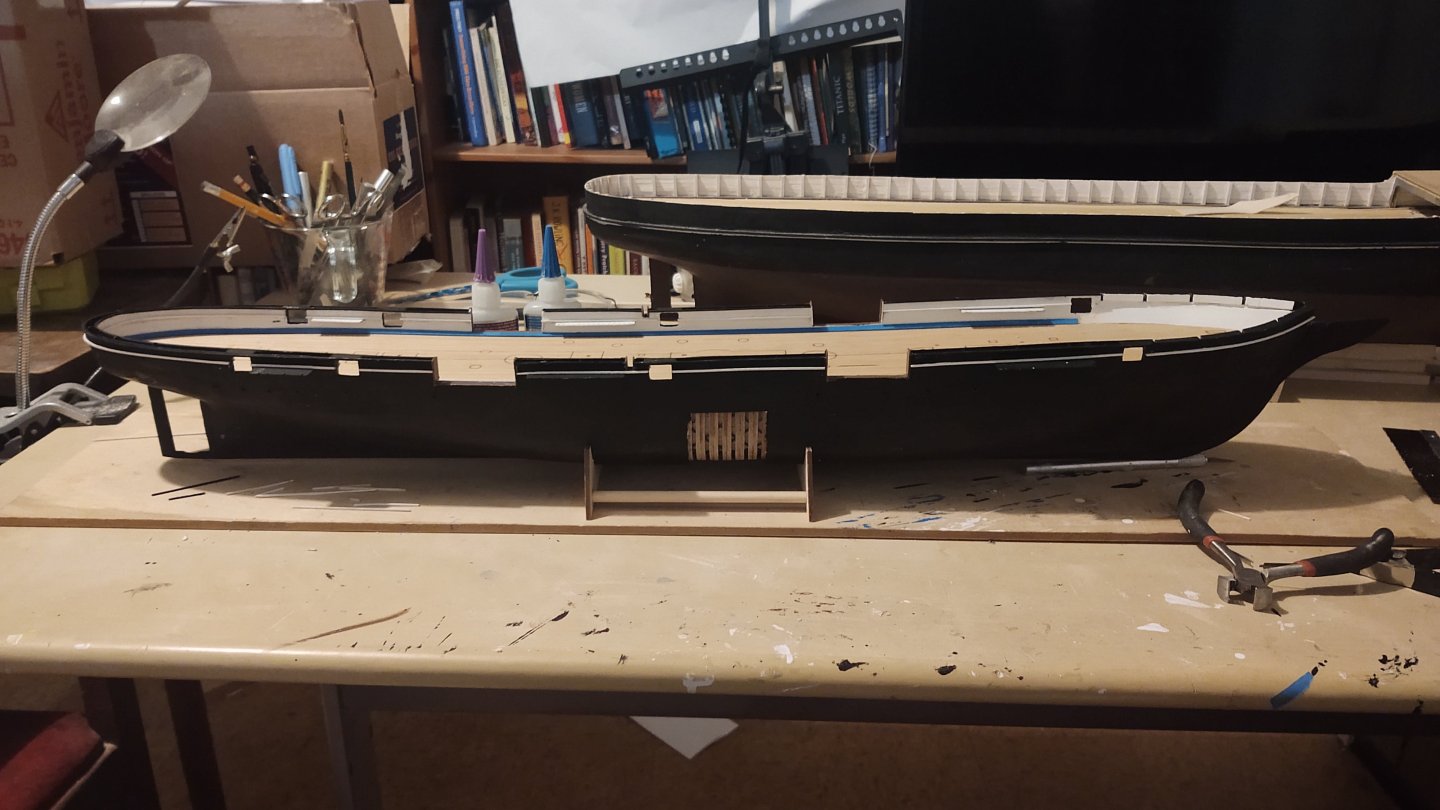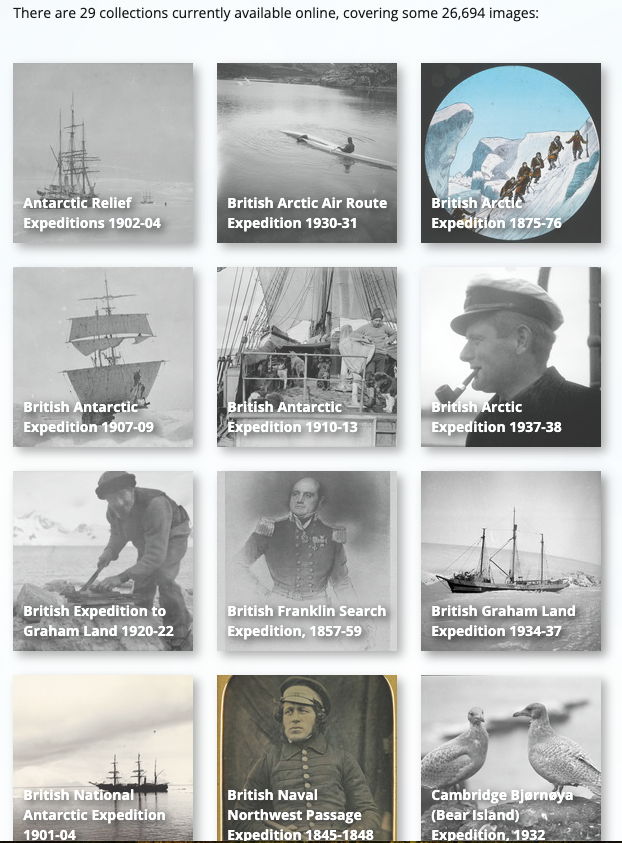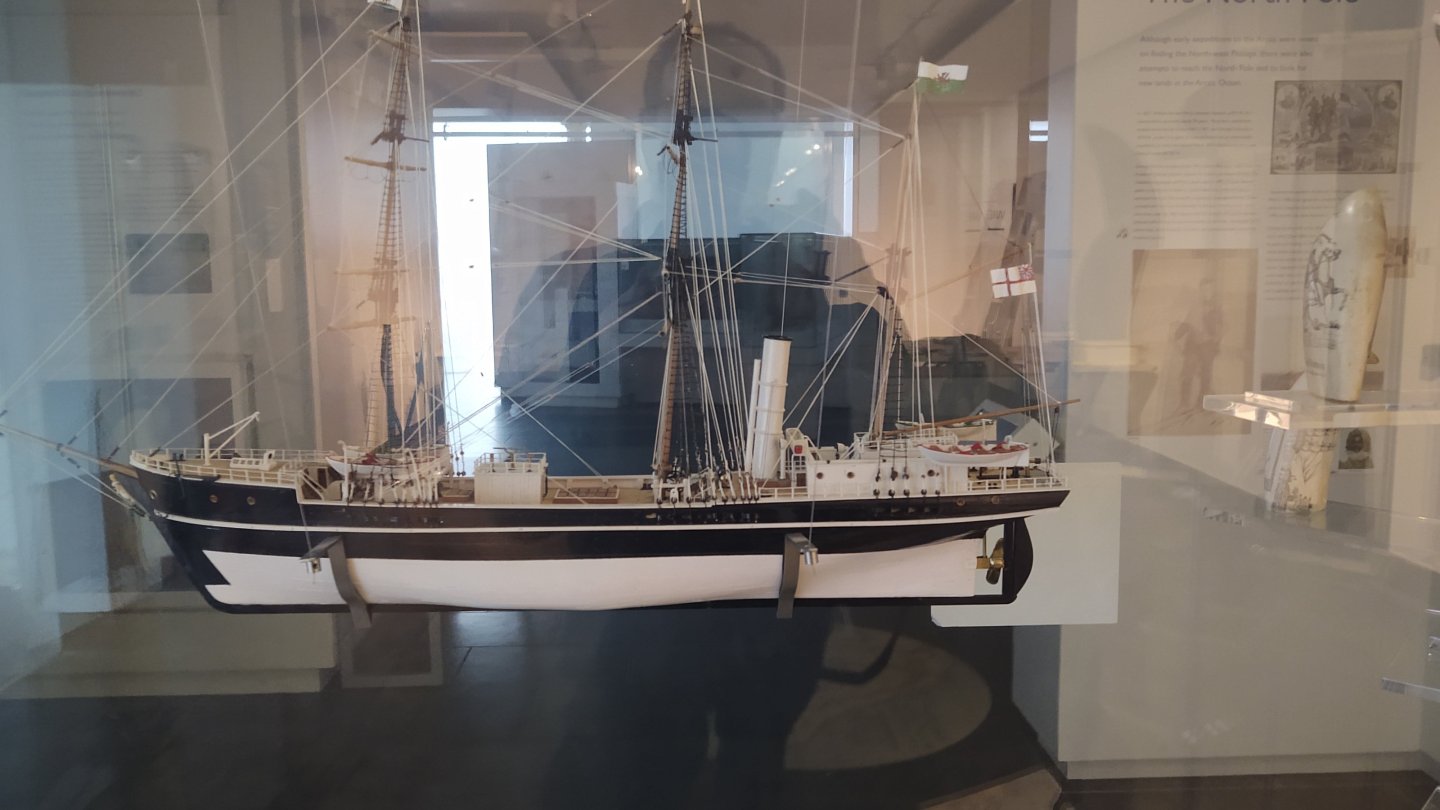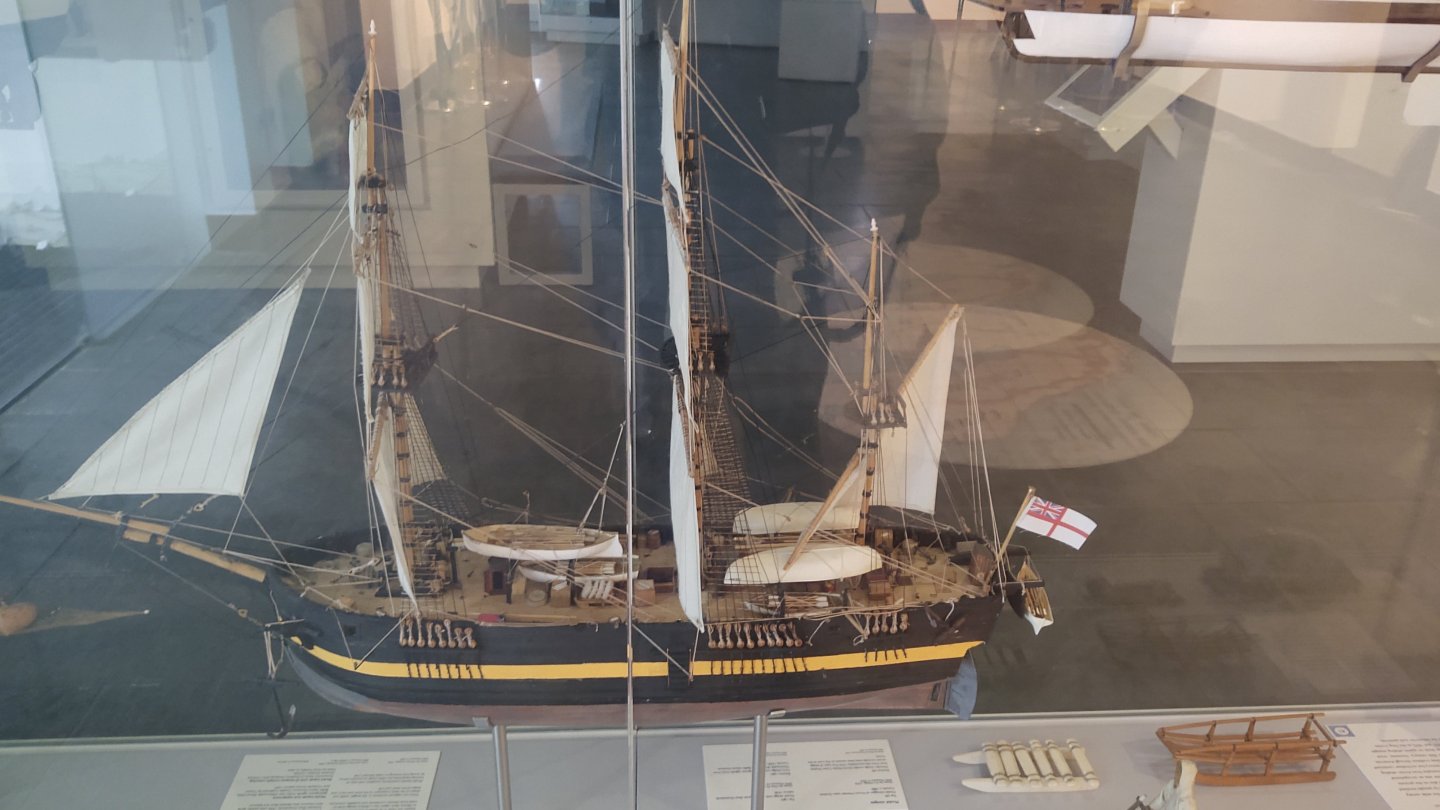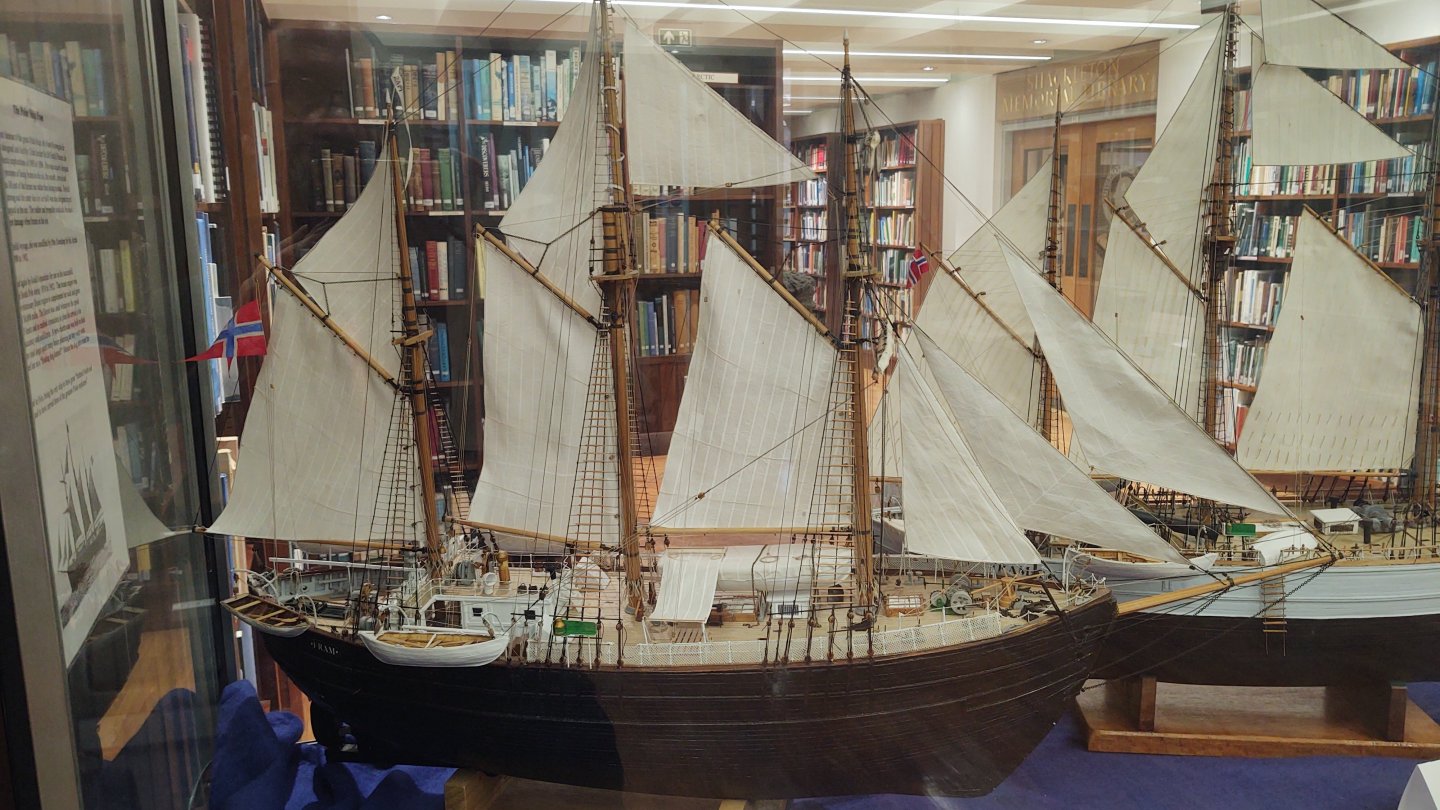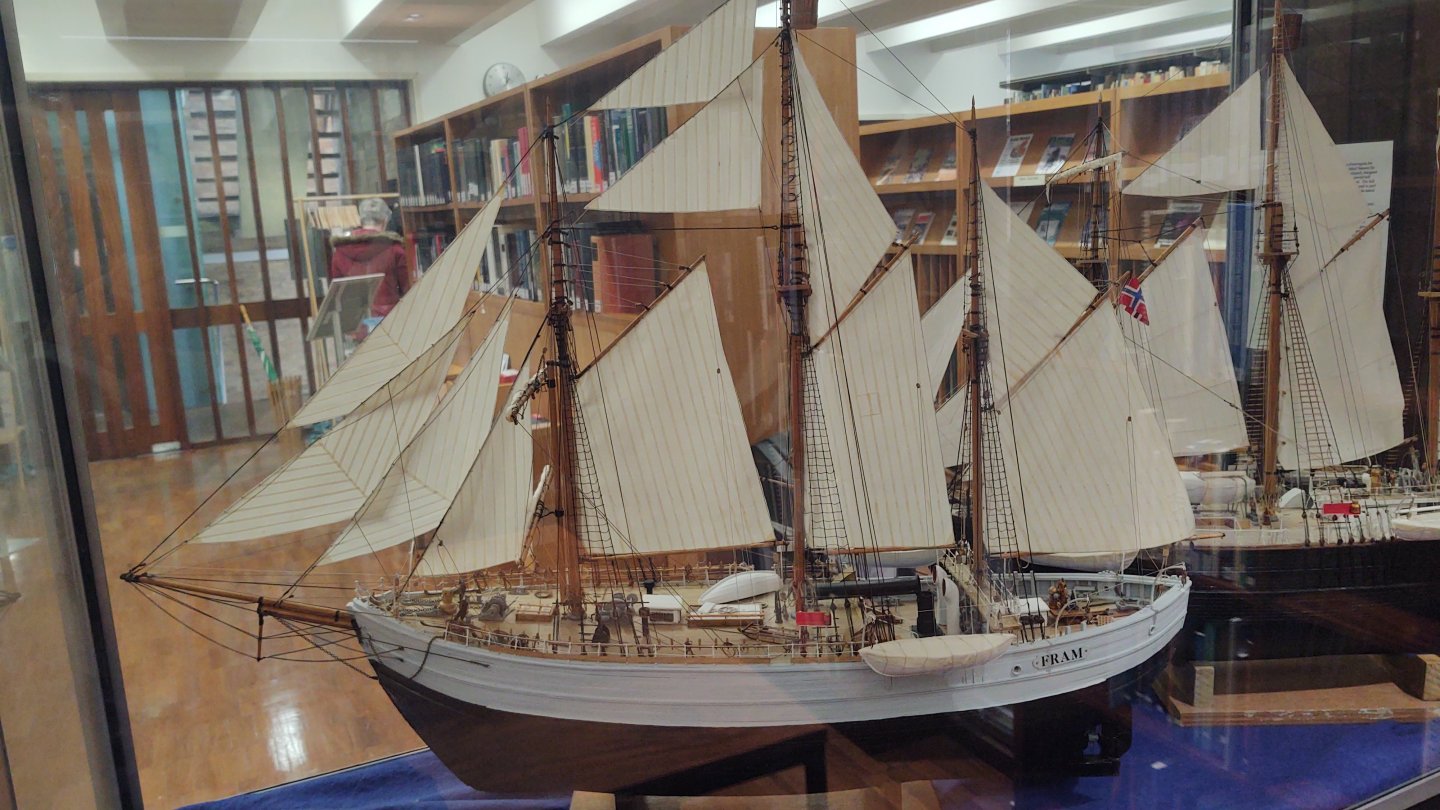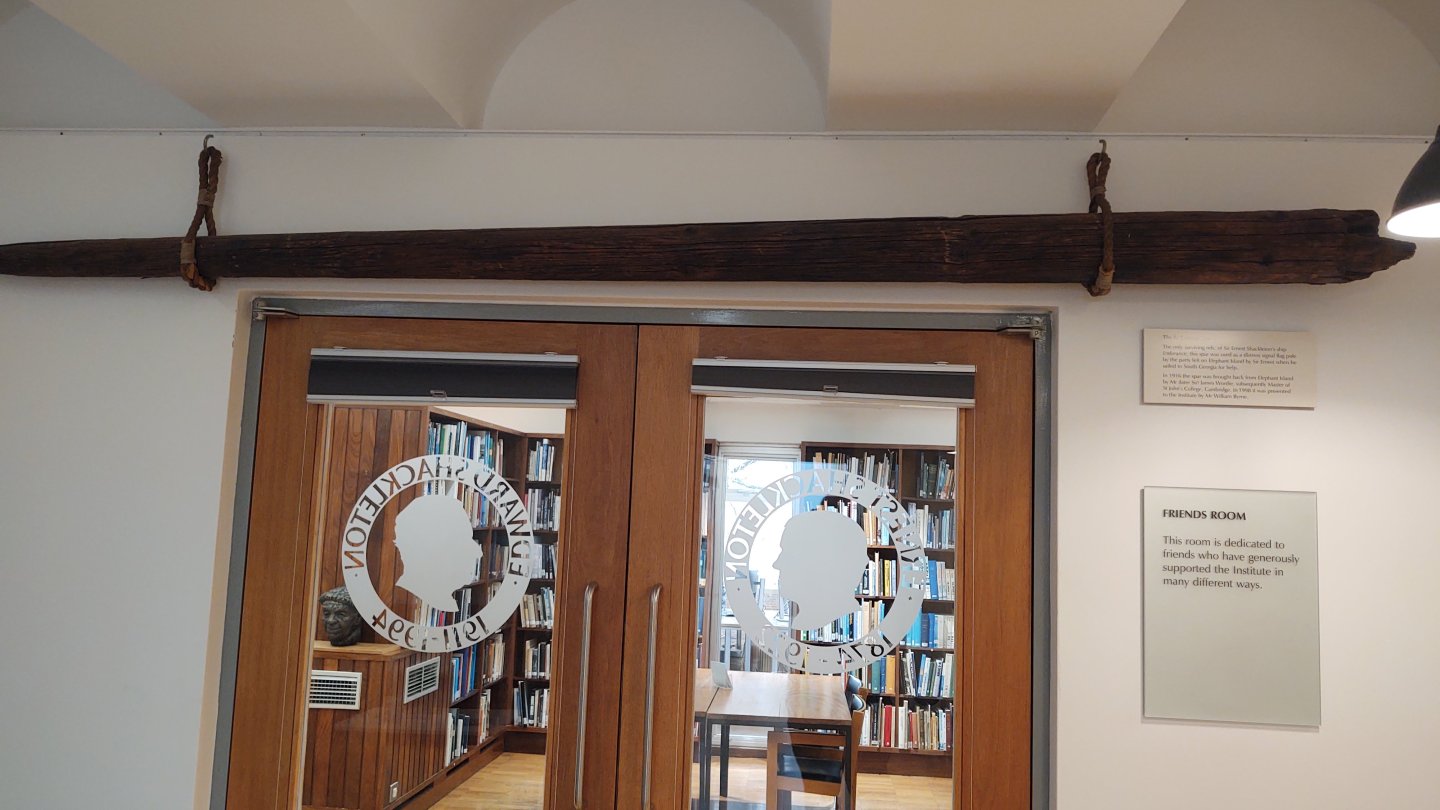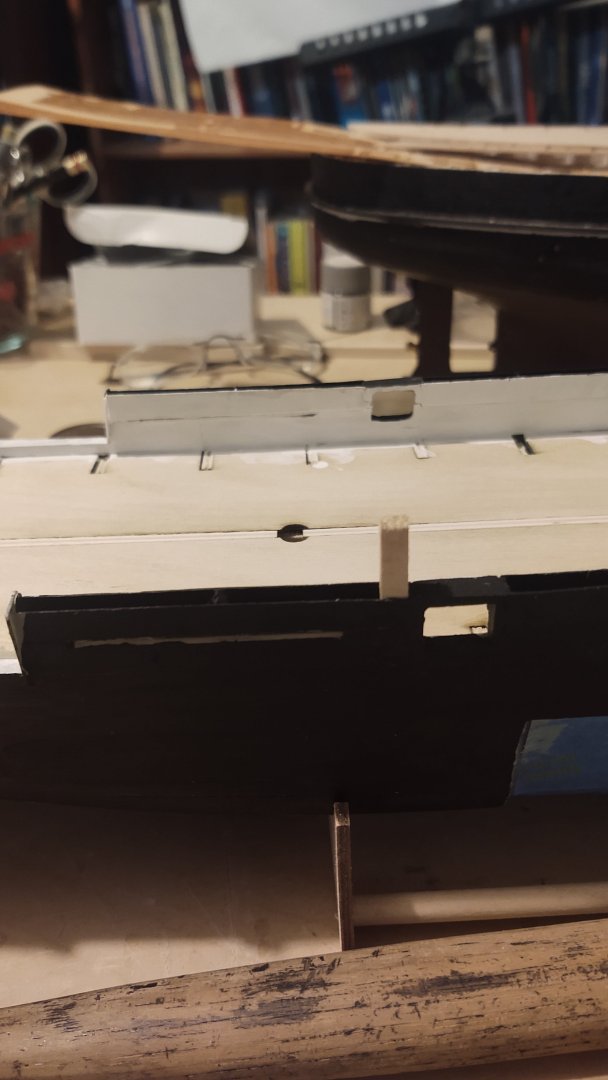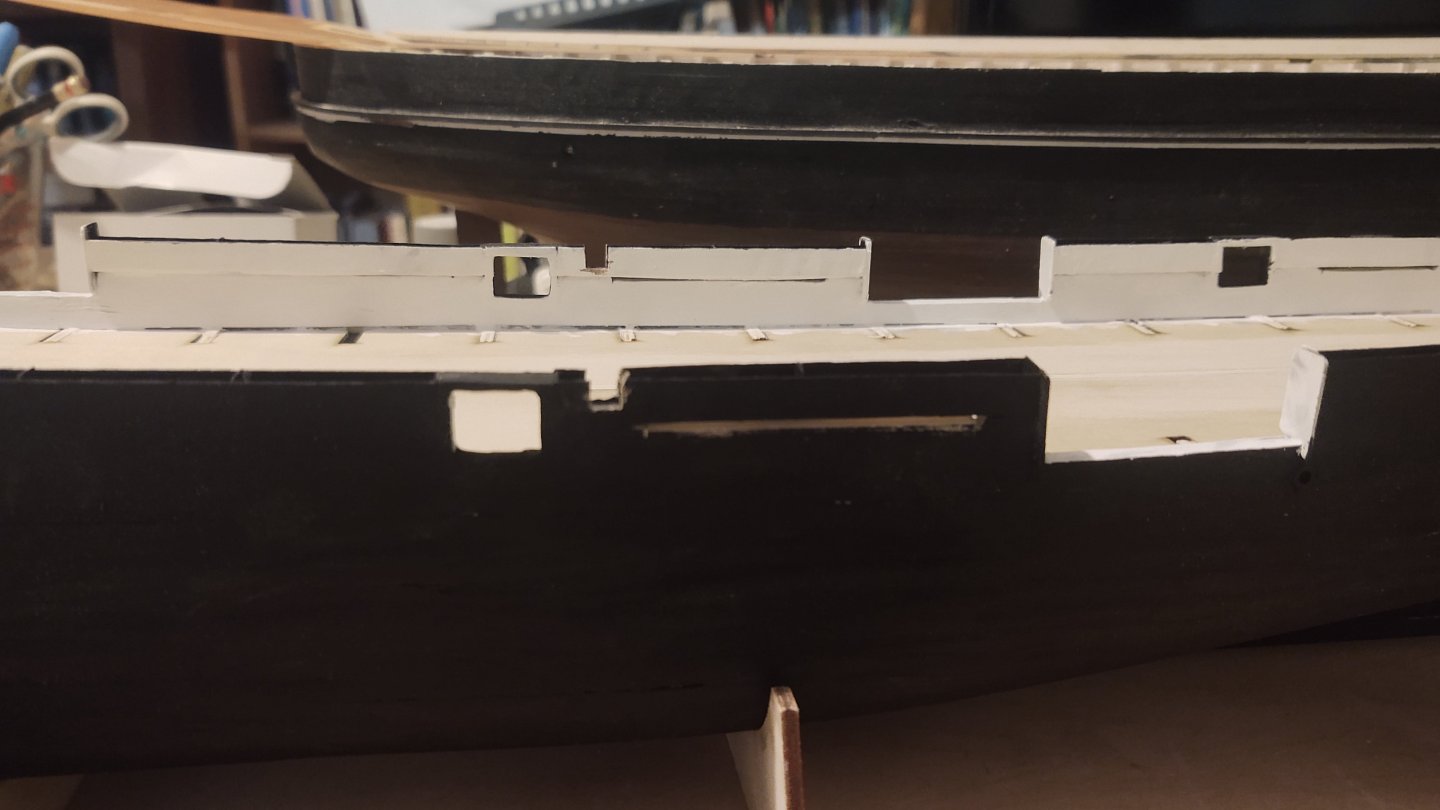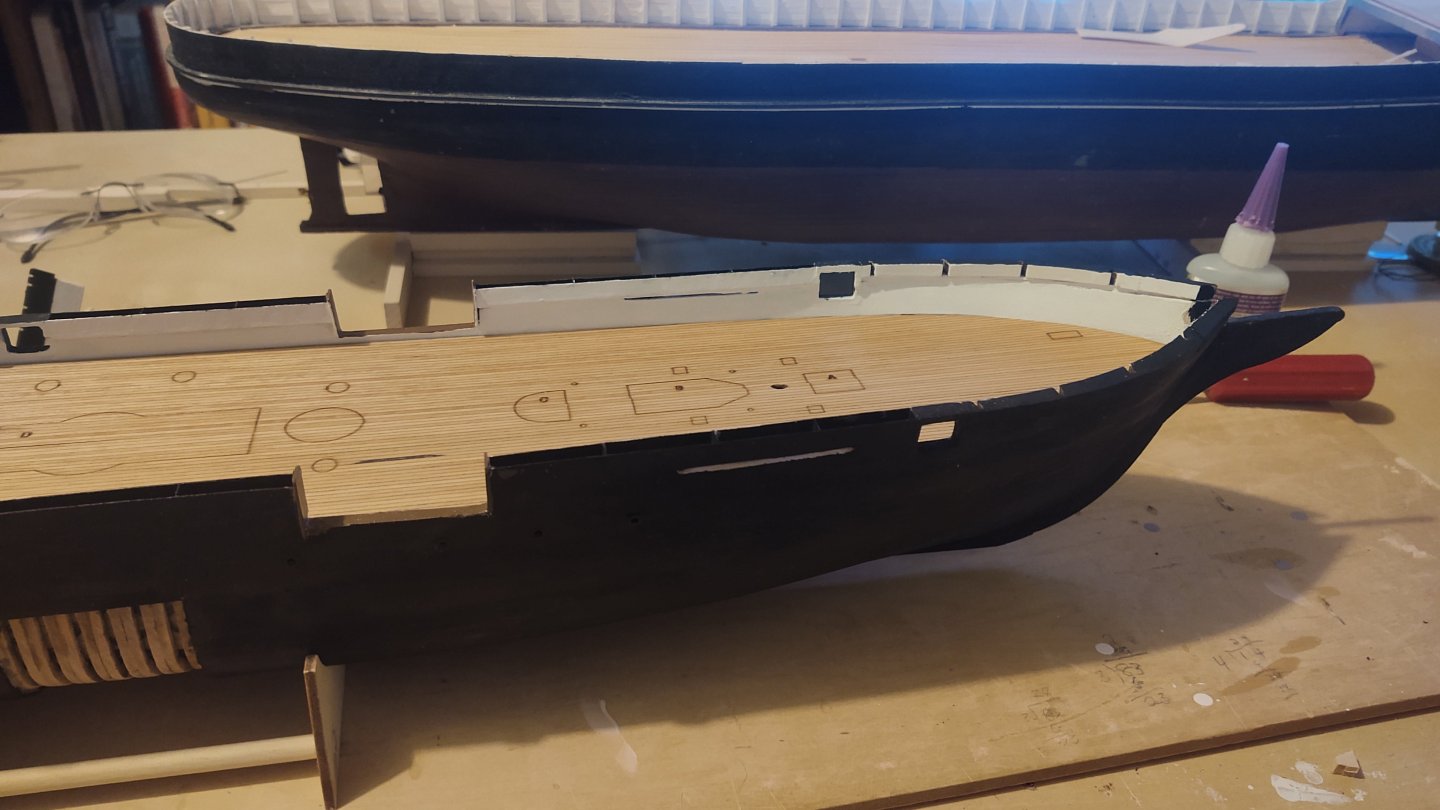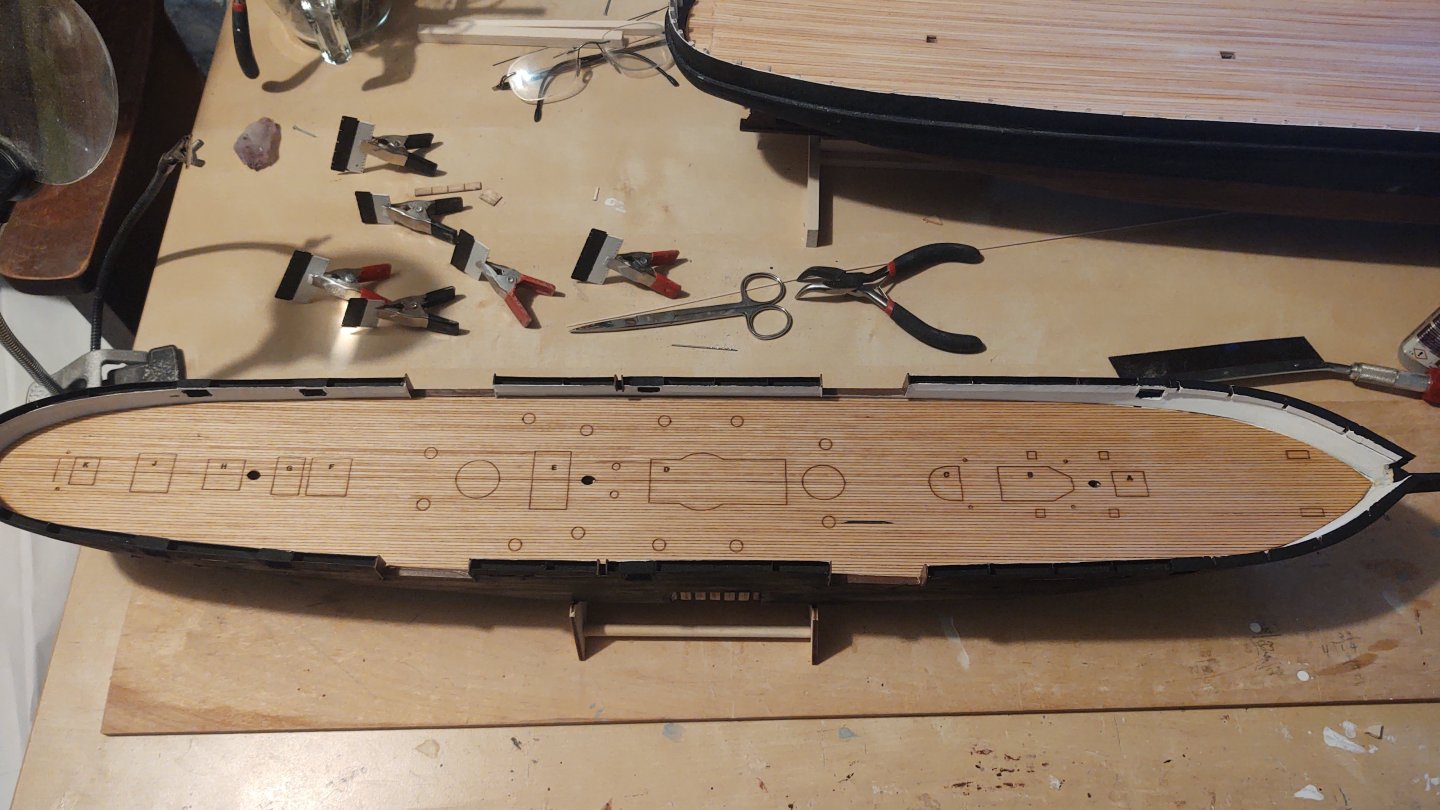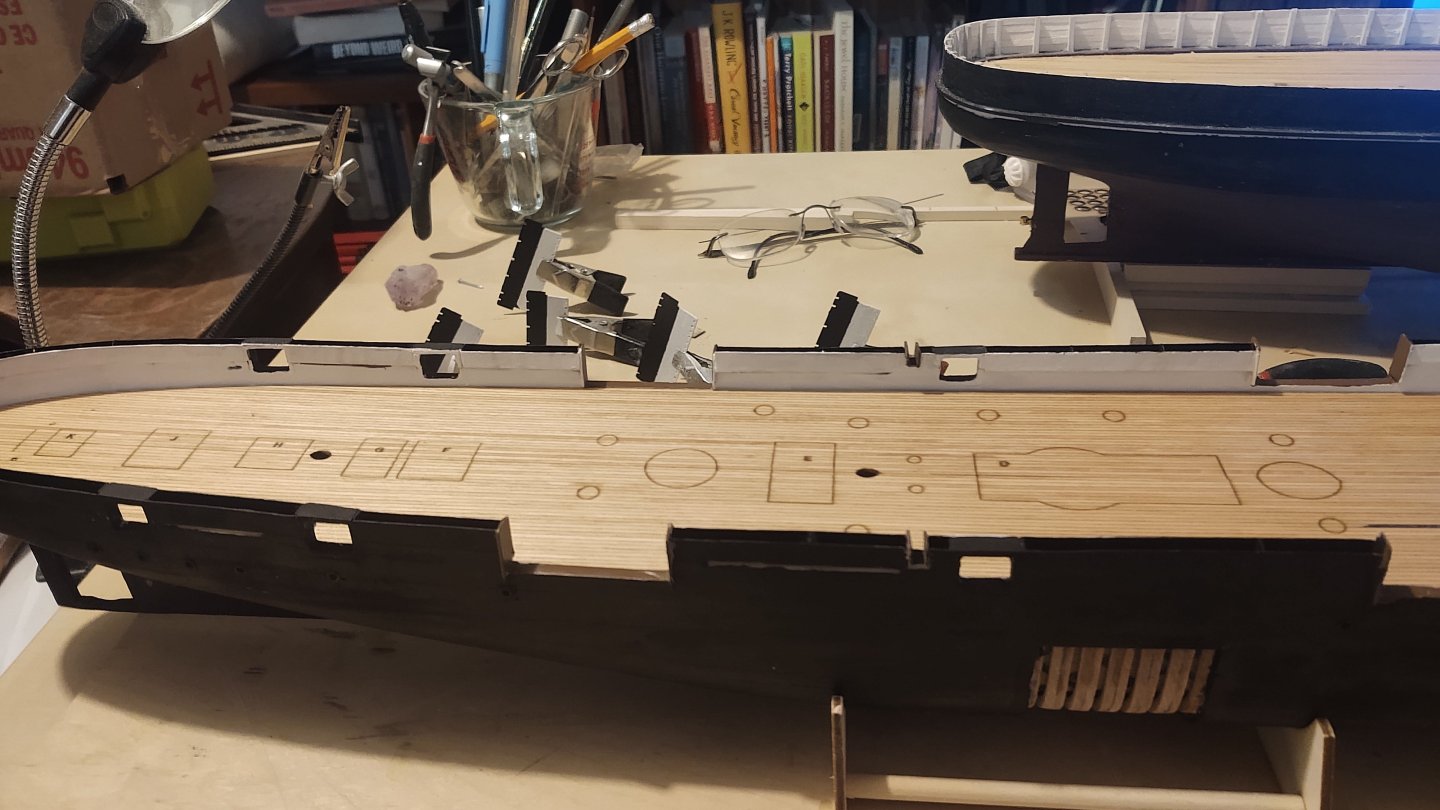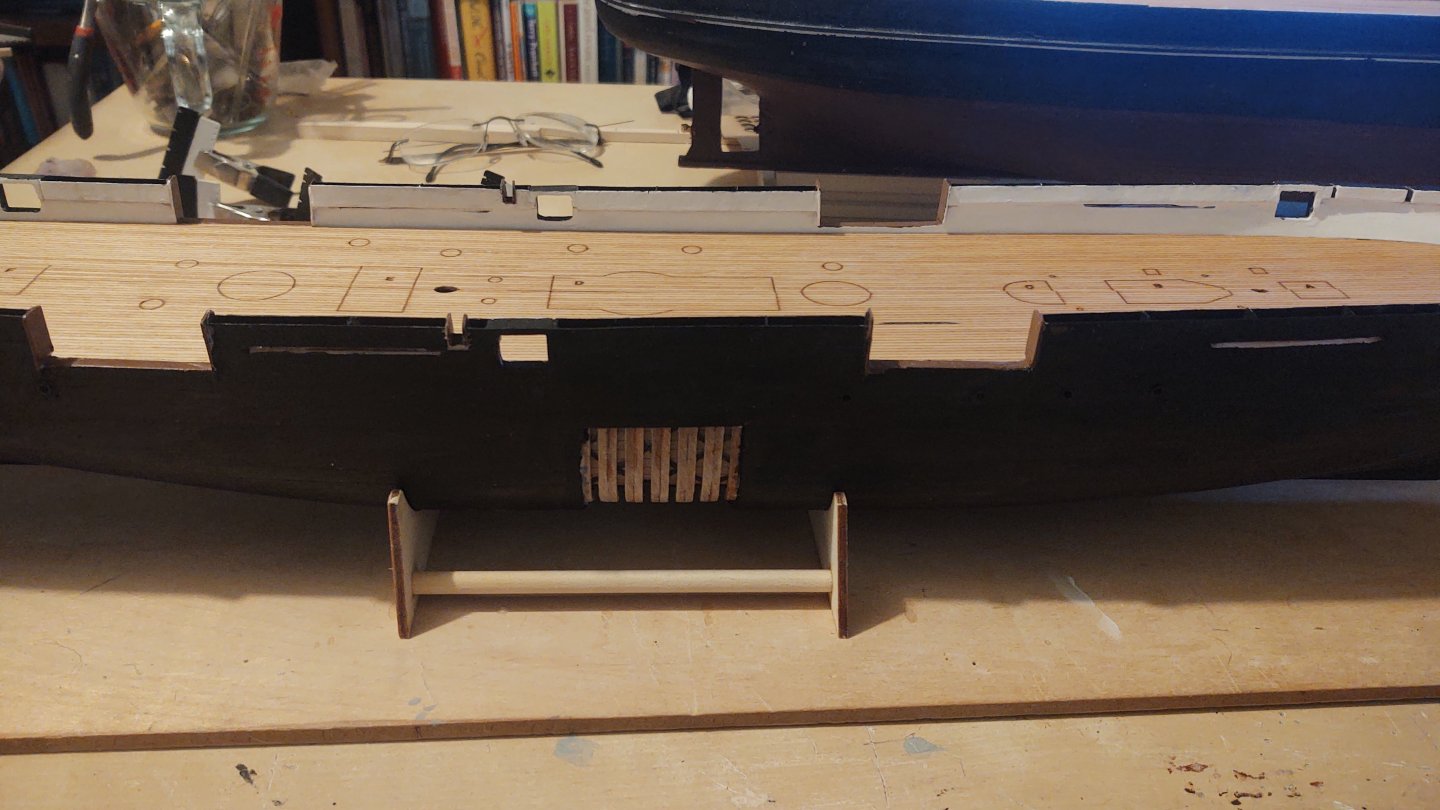-
Posts
715 -
Joined
-
Last visited
Content Type
Profiles
Forums
Gallery
Events
Everything posted by gak1965
-
Getting really close there, Jared! Regards, George
- 431 replies
-
- Flying Fish
- Model Shipways
-
(and 2 more)
Tagged with:
-
Thanks @iMustBeCrazy, @Lecrenb, and @Kevin-the-lubber, thank you for the suggestions! I tried using card, but I found it tore too easily. Maybe my blades aren't sharp enough, but it didn't work. And unfortunately, I don't have access to a 3D printer or an entity that will make a brass copy alas... However, I then returned to a thinner piece of polystyrene, and was able to make something that, I think works...? (the pieces are not glued on yet, they are just sitting there to see how they look). It's not perfect, it's probably as good as I'm going to get at this scale. I also made the shield that is the figurehead on the ship. It's not perfect, but it is probably as good as I'm going to get. Anyway, I need to make a duplicate of the scrollwork for the port side, and then I can mount on the ship. On a more amusing note. My wife and I teach math to apprentice shipwrights at the Alexandria Seaport Foundation, and when I was there, I noticed two gaffs being stored on the roof. At the jaws of one, there were standard wooden parrel beads. On the other, were these rather atypical ones: Waste not, want not, I suppose. As always, thanks for looking in! Regards, George
-
Thanks Rick. Let's just say it took more than one try and leave it at that! I've been working on the stem now. I had earlier cut and bent two pieces of wood that would represent the naval hoods (?) which have the hawse holes and the scrollwork on the stem. Drilling the hawse holes was easy, I've been working on the scrollwork which is much harder. Here is the ship stuck in the ice in 1901, you can see the scrollwork (probably gilded since it is a different color than the white stripe). Here is the ship in 2010 with (nominally) the original bow: Here is the ship today with a replacement (nominally identical) bow (licensed CC-BY at https://commons.wikimedia.org/wiki/File:1901_wurde_die_RRS_Discovery_in_Dundee_vom_Stapel_gelassen._02.jpg: The scrollwork is, to say the least, complex. My original thought was to simplify somewhat, cut it out from 1/32" thick bass, sand the edges, paint them, and mount onto the naval hoods (or whatever the correct terminology is). However, I have found that I can't cut even a simplified version out of 1/32" bass, the things just break (repeatedly). I've tried cutting things out from polystyrene sheet. This seems more promising, but getting something that doesn't look like it was done by a child has proven complicated. Any thoughts on this? I've looked at some of the carving tutorials on the site, but they seem more focused on taking pre-cut items and carving them to be more three dimensional. Are there other materials I should be thinking about? I know that I'm going to have to simplify it given the scale, but so far my best attempts have looked simplistic at best. Anyway, appreciate any insights anyone might have. Regards, George PS - The Union Jack is going to be made separately.
-
Jared, She's really looking fantastic! Glad you took the time you needed, and are ready to proceed apace. Regards, George
- 431 replies
-
- Flying Fish
- Model Shipways
-
(and 2 more)
Tagged with:
-
Hello! I am also George from Washington, DC (well, Rockville a bit north of you). Welcome to MSW! George
-
One last propeller update. Mounted on the ship. On the stern side it is mounted into a small cradle made from brass strip and painted. On the forward side, there is a channel that runs from the shaft to the hull above (you can see it in the ship photo a couple of entries back). That is there to enable to prop to be pulled out and replaced from the deck in the event of damage. I've added that in using painted brass. So, here it is: One thing I didn't model is the actual octagonal hole that goes through the hull that allows the access from the deck (and a similar rectangular access point for the rudder). It's mostly hidden, it isn't a regular octagon, and it just went into the too hard pile. I will be modeling the access port on the deck (it's a piece of deck furniture). I mentioned that it isn't a regular octagon, but, sort of a flattened octagon. Seven sides are the same length, but one is not - I presume related to the width of the hull at the exit point, but still very weird. Anyways, have a great weekend everyone! Regards, George
-
Okay - the prop is done. Here is the basic sequence. I cut out the blades from brass sheet, using a bit of painters tape to draw the outlines: I used a knife handle to curve the blades, and then fit them into a curved cut I made in the hub: Here it is before painting: This was where I made, an, ah, mistake. I had a bottle of Tamiya "bronze" paint. Here is what it looked like after a coat of paint (yikes): So, suddenly doing additional research I should have already done (and frankly when I opened the bottle, I should have cottoned to), I learn that the bronze used on most propellers is in fact an alloy of copper, tin, and zinc, which makes it both a bronze (copper + tin) and a brass (copper + zinc). Either way, I took some Tamiya gold paint and mixed it with the bronze until I got a shade that made more sense. A quick sand with 320 grit sandpaper to even out the first coat, and we get the following: which I think you will all agree is much nicer. Regards, George
-
Concur. Plus, as the boat ages and things break, they get repaired with what is available - if it's a different size or looks a little different, well, no one is going to replace all of the block for aesthetics. She's looking great! George
- 312 replies
-
- Chile
- Latin America
-
(and 6 more)
Tagged with:
-
Quick question. So, I gather most propellers were made of bronze (even to this day). What would the shaft have been made of in 1901? Iron? Steel? Bronze? Trying to decide how to paint the shaft. I mean, Given that this is meant to be removable, would it make the most sense for it to be a single bronze casting? Any help appreciated. Thanks, George
-
I tend to use annealed wire as well - same reasons - it's black and easy to work with. GAK
- 345 replies
-
- Flying Fish
- Model Shipways
-
(and 1 more)
Tagged with:
-
@Rick310, appreciate the comment! Now, the prop. Here it is on the ship. My initial question was how to make the ball that holds the blades and the shaft as one piece, two pieces (a ball with a hole drilled through it for the shaft), or three (a ball with two dowels glued on as shaft segments. My initial thought was to try to fabricate it as one piece and see where we go from there. This is one place where the plans have let me down, as they don't show much detail on the prop - so I've been forced to work from photographs like the above. The "ball" at my scale should probably be in the 12-15 mm diameter range with about 4 mm worth of shaft visible. I didn't have a big enough dowel or single piece of wood handy, so I glued up 12 segments of 1/4" by 3/16" (4x3) into a 3/4 by 3/4 inch wide billet, cut it in two, and mounted it in my little lathe. So, step 1 was to round out the square billet (this photo is from attempt 1, all of the others from attempt 2). I've also started defining the boundaries of the shaft vs. the ball. Here it is further along. I've defined the ball and shaft pretty definitively, marked the center of the ball, and started cutting away ball shape on the right hand side. And here it is after trimming further, and sanding with some 150 grit. I've cut it out and I need to see if it is visually the right size (it may be a bit too large), in which case, I'll put the piece back in and sand it down until it appears correct. Once that is done, fill any gaps and cut out where the blades will mount into the ball. I'm not going to try to model the "bolted on" blades at this scale, but I think it's going to look just fine. As always, thanks for looking in and for the likes. Regards, George
-
Today's update is the rudder. This is the rudder as it was when the Discovery was in dry dock in Australia (a section from https://www.spri.cam.ac.uk/picturelibrary/catalogue/article/p83.6.2.3.2/: The rudder is one piece, and quite wide (as wide as the sternpost), and doesn't seem to have much in the way of beveled edges. Here is the blank: Rather than build a separate iron work for the pintle, I made the "iron" pintle holder out of wood, and glued slightly smaller dowel pieces above and below, and then shaped the wood that represents the iron holder semi-circular. The rudder was then painted hull red, as all of it is below the waterline. The rest of the "iron work" was made from 1/4 inch copper tape that I cut to 1/8". I made the "bolt heads" with a nail and a ball peen hammer, and then painted the copper black, and added it to the rudder. The pintle was fitted into the previously made gudgeon, and the top of the rudder glued into place. As always, thanks for looking in and the likes. Regards, George
-
Thanks Jared. Looks like it's going to work out in a good way, particularly given my father and in-laws advanced age. Back to the actual ship (which had been sitting on the side for a bit while I did some work on the Kearsarge. The forecastle on Discovery is closed off, so I needed to build up a bulkhead with two doors. Here is a photo of the real ship (from the Scott Polar Institute website): It's hard to see (although not on the original) that the bulkhead is made up of vertical sections of wood that appear to be about 3 feet thick, and there are two doors. The insides of the doors are white, but it looks like the outside is darker (and that is the way the ship is today - although that is of questionable value for here. I want the bulkhead on the model to be 1/16 inch thick and still show the vertical planking. First thing, was a took a piece of 1/32" thick stock and fitted it to the opening to the forecastle. Then I took my 1/32" stock and made 6 mm wide strips, which I cut and glued onto the piece I had cut out and fitted to the opening. Here it is partially complete: And here it is, complete, partially sanded. After sanding it to fit, I cut out the openings for the two doors, put some scrap behind the openings for the doors to fit into, and painted it white, as per the photograph. Then, install into the opening: The base of the bulkhead is 1/32" square basswood stained red oak. I made the doors out of some scrap, scribed decking I had from another project, backed with 1/32" basswood. The doors were stained with red oak, so that the scribing still comes through, while providing some contrast. I glued a bit of stained 1/32" square bass on the base of the door as in on the bulkhead, and used leftover belaying pins for the doorknobs. The hinges were made out of brass. I didn't paint the hinges because they were within about 30 feet of the magnetic observatory, and would have fallen under the "no ferrous metal" rule, like the fore chainplates, which were made out of brass. One door was closed and the other left ajar: Finally, I mounted a bit of 1/32" square stock painted white across the top of the bulkhead, a similar decorative touch is visible in the photograph. All in all a lot of work, considering that the vertical lines are practically invisible. BTW, one of the reasons that the port door is open is so I can get to the anchor points for the lower forestays which are in the forecastle. So, the door should swing open more, but since there is nothing to see in there, it will likely stay only ajar once the stays are in place. As always, thanks for looking in, and the likes! I hope everyone had a wonderful St. Patrick's Day if you indulge. Regards, George
-
My wife and I were both graduate students there with the relevant crew of friends at JPL. A bit of an aside, I was telling my younger daughter over the weekend how we watched the telemetry coming in live from the 1989 Voyager 2 encounter with Neptune. It was a combination of incredible excitement (the first images from Neptune!) and watching paint dry, because the transmission bit rate was so low it would take a minute or more to do a single line of one image. Still pretty cool. George
- 425 replies
-
- minesweeper
- Cape
-
(and 1 more)
Tagged with:
-
Yep. I lived in LA 9 years in the mid 80s to the late 90s. It was much better then, but because the inshore breeze keeps LA (but not the San Gabriel Valley where we lived) cool, it also pushes all the smog up against the mountains so that they become hard to see. My first day in Pasadena, I was told that there the San Gabriel Mountains were only 5 miles away, and yet I couldn't see them. On better days (and especially after a rain, or when the Santa Ana winds come off the desert, the view from the airport is unbelievable.
- 425 replies
-
- minesweeper
- Cape
-
(and 1 more)
Tagged with:
-
An update on the Kearsarge. The next step was to put the trim (black and white) on the hammock netting. On both the inside and the outside it is black on top and white on the bottom of the nets. Because the aft of the ship has a fairly sharp curve, I soaked the 1/32 square stock, fitted it around the curve, and let it dry. While I was at it, I soaked the basswood that was going to become the waterway and clamped it in place until it dried. In the photo below, the trim for the hammock nets is outside, and the waterway is inside (the deck is not yet tacked down). Once dry, I painted half of the trim black, and the other half white, and then painted the waterway blue. I mounted the trim to the hammock netting, and once the black (upper) trim was in place, I also touched up the black paint at the top. Next, I attached the deck, and then fitted the waterway in place. In the photos below, I have temporarily fitted the pieces that produce the channels and the pinrails. Here is the ship from a couple of angles. First the whole ship (with the 1:72 Discovery in the background. The forward half of the ship. As you can see there is a visible gap that is retained, but that is where the tracks for the guns will sit, and I will probably align the gun to cover it up. There is also a small issue between the deckhouses in the stern, but as described, a bit of rope or other item will no doubt cover that up. Anyways, thanks for looking in, and a Happy St. Patrick's Day to those that partake! I will probably set this aside for a little while and do some work on the Discovery for a little while. If I do work on it, it'll probably be to put the copper plating on. Regards, George
-
Appreciate it guys. FWIW, my younger daughter kept telling me that if this potential employer had been a man, I wouldn't want her dating him! So, probably for the best. The Scott Polar Research Institute was quite cool. They operate a small museum, library, and picture library, and obviously support research. They were extremely accommodating - all I had to do was sign up for a study desk in the picture library, and they brought me whatever I asked for. The URL for the institute is here: https://www.spri.cam.ac.uk/. They cover a whole range of expeditions, not just Scott's, and they have a nice (if incomplete) online picture catalog. Great people all around. Regards, George
-
Well, I am back from the UK. 9 hours of interviews in Manchester (Thursday), 8 hours of interviews in Oxford (Friday), and then a panel in London (Tuesday). I returned Tuesday night to another 3 hours of interviews for something else Wednesday morning - most of us are generally best jet lagged out of our minds. Alas, I will not be moving to the UK, I found out the day after that they had decided on someone else (I was one of 4 at that point). I wasn't overly surprised, but rather than contacting me directly, they went through the search firm to tell me. Okay. With that said, on Monday, I did one of the coolest (ha ha!) things I've even done. I went to the Scott Polar Research Institute in Cambridge, and they let me look at the ORIGINAL photo albums from the 1901-1904 British Antarctic Expedition. I couldn't take photos, but I got 2.5 pages of notes on details about the ship. The facility also had some pretty cool artifacts. A model of the Roald Amundsen: Here is a model of the Fram. The Erebus: The Terra Nova: Tagging @Tomculb who is working on Endurance, this is the only piece of the ship that made it home: Like I said, very cool. Getting back to work on the ship this weekend. Regards, George
-
Rick, This isn't necessarily correct but here's where I put the davits so between the 3rd and 4th mizzen shroud (counting fore to aft) and just aft of the main chainplates. I found that running the davit lines was complicated, but I was able to do so without interference if I was careful. The build log entry is here: The boats are looking great! GAK
- 345 replies
-
- Flying Fish
- Model Shipways
-
(and 1 more)
Tagged with:
-
A bit of an update. Outer hull is painted black, ready for the coppering. Inner bulwarks are painted white. I realized I hadn't cut out the sally ports, so I did that. I stuck a piece of 3/16 wood in the hammock netting to stabilize it while I made the cut, and the put brown painted hammock net ends in place. I spent some time finishing the deck and trimming it to size. Here are some photos (not tacked down). The combination of the stain and the suggestions from Tim and Nic removed most of the apparent gap. Once it's tacked down it will be even less obvious. No more for at least a week as I am I. The UK for a job interview in Manchester, Oxford, and London and won't return until next Tuesday. Thanks for looking in. Regards, George
-
Hm. I assume that the wrapping isn't transparent? Might have been interesting to look at the structure, but perhaps not ideal. FWIW, the last few times I've been in Boston (which tended to correspond to move in/move out dates where my kids where in college), the Constitution was similarly or at least partially dismasted. Yep - I've visited the Cutty Sark (and the NMM and the Royal Observatory) in her current (post fire) state. I was really impressed with how well they have her displayed, and it was very cool to walk under the keel. I thought about it. The interviews are in Manchester, then Oxford, then London. I will have a bit of time the day before the Manchester interview and depending on a bunch of imponderables (where the hotel I'm being put up is relative to the airport and train station, I might be able to take the Transpenine express to Edinburgh and then Scotrail. My concern is that I absolutely have to be at the interview site in Manchester at 9:30 AM the next day and I don't like being dependent on trains like that. I hadn't thought about a plane. London to Dundee seems to about the same distance is Washington DC to Boston, and I've certainly taken day business trips to Boston. I need to think about that. The main reasons I had kinda decided to do something else was because (a) I wanted to be within driving distance and (b) because the ship in Dundee isn't really the ship I'm modeling. Discovery was heavily modified in 1923. The only thing above the main deck that is the same is the engine enclosure. All of the rest of the deck furniture was changed, the masts moved and switched to a different rig (from 4 to 5 yards on the fore and main). It would be cool to see, but the time factors (4 hours sitting in airports + 3 hours airborne + 3 hours in hire cars) - I dunno. If the job offer comes through and I take it there will be lots of time to visit Dundee. Maybe Bristol|Bath|Brunel this trip - though I'm sure the thought will be in back of mind for the next couple of weeks... Regards, George
About us
Modelshipworld - Advancing Ship Modeling through Research
SSL Secured
Your security is important for us so this Website is SSL-Secured
NRG Mailing Address
Nautical Research Guild
237 South Lincoln Street
Westmont IL, 60559-1917
Model Ship World ® and the MSW logo are Registered Trademarks, and belong to the Nautical Research Guild (United States Patent and Trademark Office: No. 6,929,264 & No. 6,929,274, registered Dec. 20, 2022)
Helpful Links
About the NRG
If you enjoy building ship models that are historically accurate as well as beautiful, then The Nautical Research Guild (NRG) is just right for you.
The Guild is a non-profit educational organization whose mission is to “Advance Ship Modeling Through Research”. We provide support to our members in their efforts to raise the quality of their model ships.
The Nautical Research Guild has published our world-renowned quarterly magazine, The Nautical Research Journal, since 1955. The pages of the Journal are full of articles by accomplished ship modelers who show you how they create those exquisite details on their models, and by maritime historians who show you the correct details to build. The Journal is available in both print and digital editions. Go to the NRG web site (www.thenrg.org) to download a complimentary digital copy of the Journal. The NRG also publishes plan sets, books and compilations of back issues of the Journal and the former Ships in Scale and Model Ship Builder magazines.




